Rustic dining rooms embody the perfect blend of warmth, comfort, and natural beauty that transforms everyday meals into memorable gatherings. These spaces celebrate organic materials, weathered textures, and timeless craftsmanship while maintaining modern functionality. Whether you prefer the refined elegance of modern farmhouse design or the rugged charm of mountain lodge aesthetics, rustic dining rooms offer endless possibilities for creating inviting spaces. From reclaimed wood tables anchoring the room to statement lighting fixtures casting a warm glow, each element works harmoniously to establish an atmosphere of relaxed sophistication. These design ideas showcase complete rustic dining room themes that embrace authentic materials, thoughtful layouts, and carefully curated details.
1. Reclaimed Barn Wood Rustic Dining Room Paradise
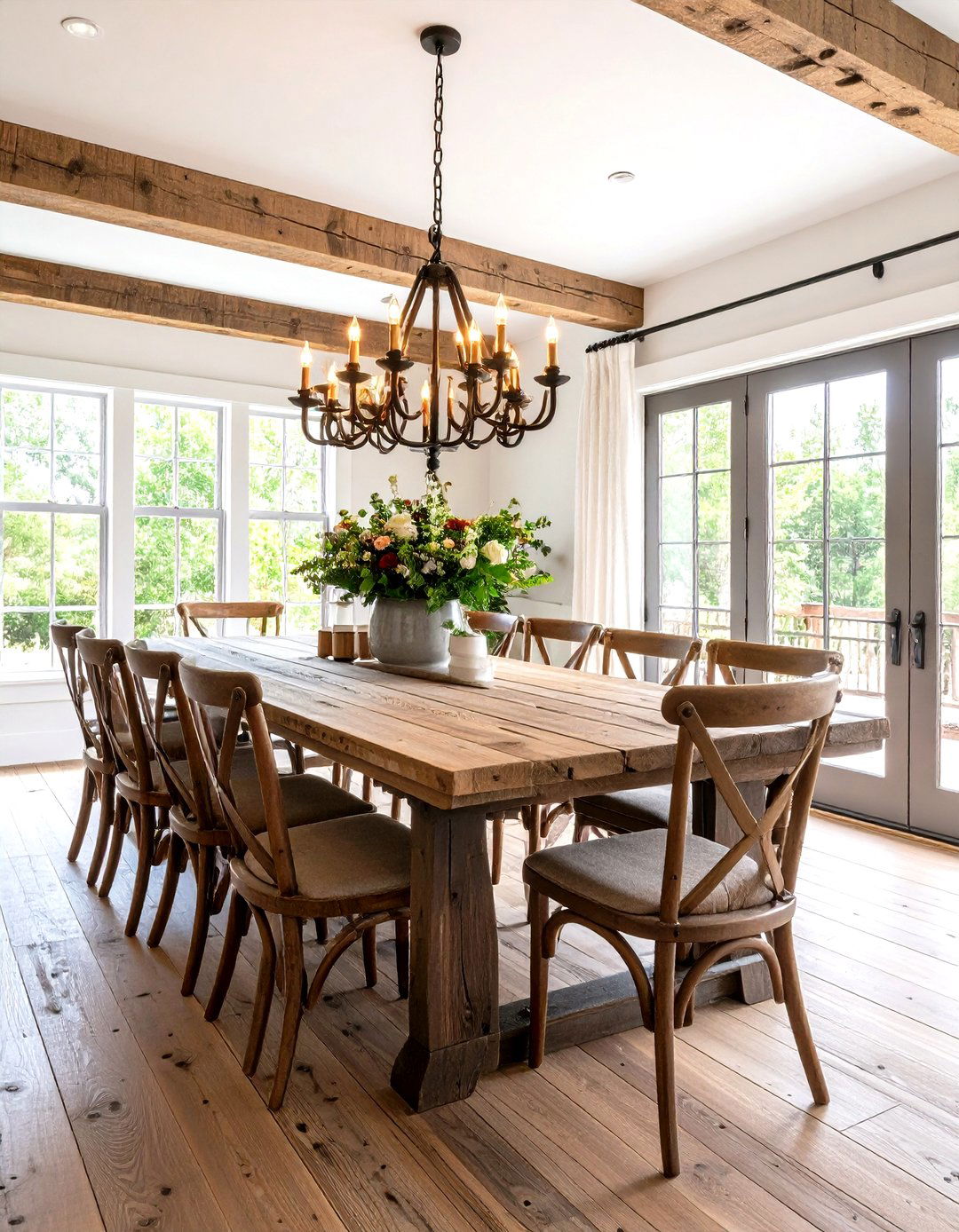
Transform your space with authentic reclaimed barn wood that tells stories through every weathered grain and nail hole. This comprehensive design centers around a massive farmhouse table crafted from century-old barn planks, complemented by matching wainscoting that extends halfway up neutral-painted walls. Exposed ceiling beams in similar reclaimed wood create architectural drama while supporting wrought iron chandeliers with Edison bulb fixtures. Complete the authentic atmosphere with vintage Windsor chairs showing natural wear patterns, galvanized metal accessories, and mason jar centerpieces filled with seasonal wildflowers. Stone or brick flooring grounds the space, while burlap table runners and linen napkins add softness. This design celebrates the beauty of imperfection, where each scratch and weathermark contributes to the room's authentic character and rustic appeal.
2. Modern Farmhouse Rustic Dining Room Elegance
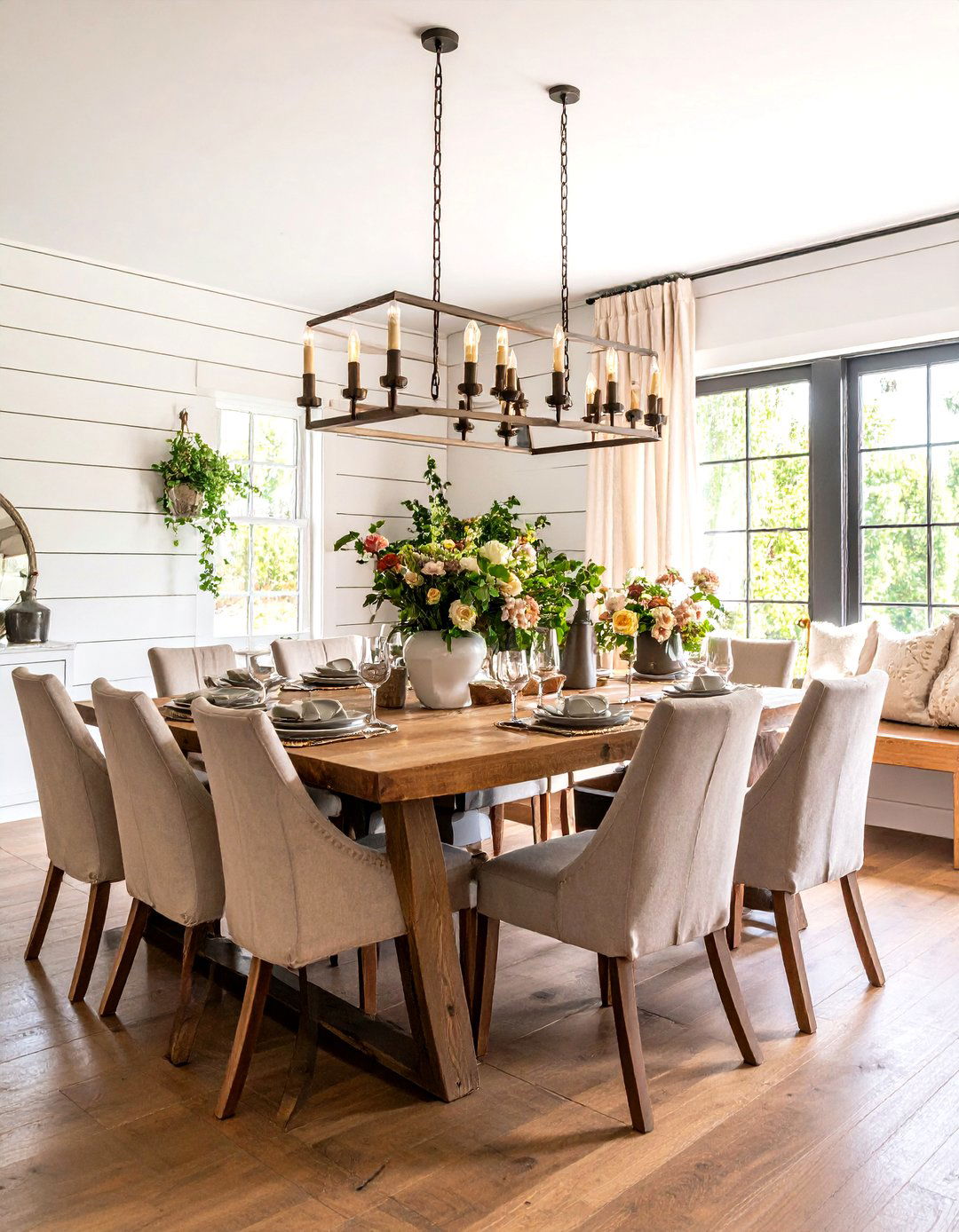
Achieve sophisticated country living by blending clean contemporary lines with rustic farmhouse elements for a fresh, updated aesthetic. Center the space around a sleek white-painted farmhouse table paired with mismatched seating that combines upholstered dining chairs in neutral tones with a rustic wooden bench. Install shiplap accent walls painted in soft gray or cream, while leaving other walls in crisp white for balance. Suspend a linear metal chandelier with vintage-style bulbs over the table, complemented by modern pendant lights in the adjacent kitchen area. Add industrial touches through black metal cabinet hardware and window frames. Incorporate natural textures via jute area rugs, woven baskets for storage, and potted herbs on floating wooden shelves. This design creates a harmonious blend of rustic charm and contemporary sophistication.
3. Industrial Rustic Dining Room with Metal Accents
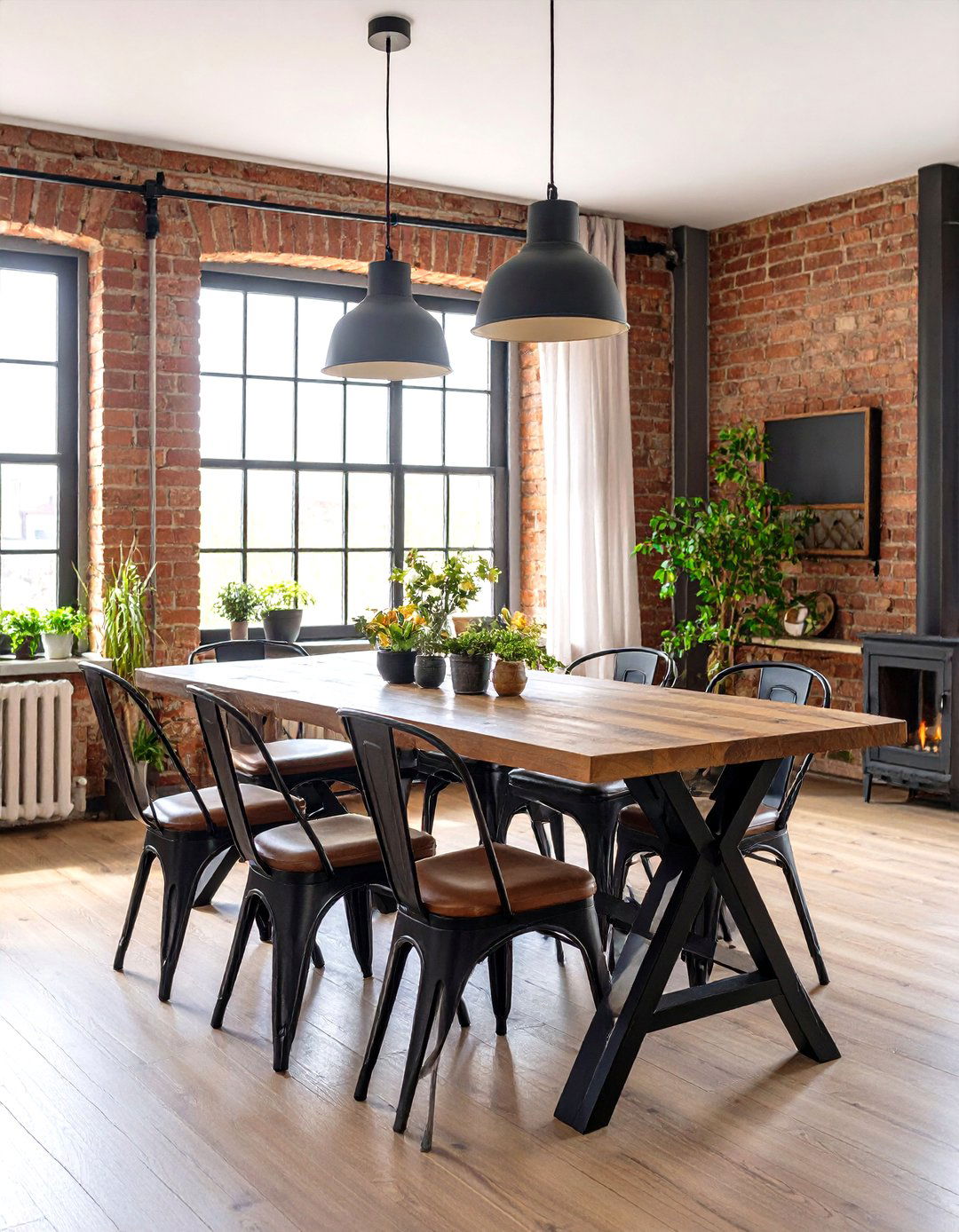
Create an edgy yet warm atmosphere by combining rustic wood elements with industrial metal details for a unique contemporary feel. Feature a dining table with a thick reclaimed wood top supported by black steel legs or a metal trestle base. Complement this with metal dining chairs featuring distressed leather or canvas upholstery in rich browns and deep grays. Install factory-style pendant lighting with metal shades suspended from black iron tracks or chains. Expose brick walls or add brick veneer to create textural interest, while incorporating steel beam accents or metal shelving units for storage. Complete the industrial aesthetic with concrete or polished concrete floors, vintage factory stools as additional seating, and metal accessories like galvanized planters and industrial-style clocks. This design perfectly balances the warmth of rustic wood with the coolness of industrial materials.
4. Cozy Cabin-Style Rustic Dining Room Retreat
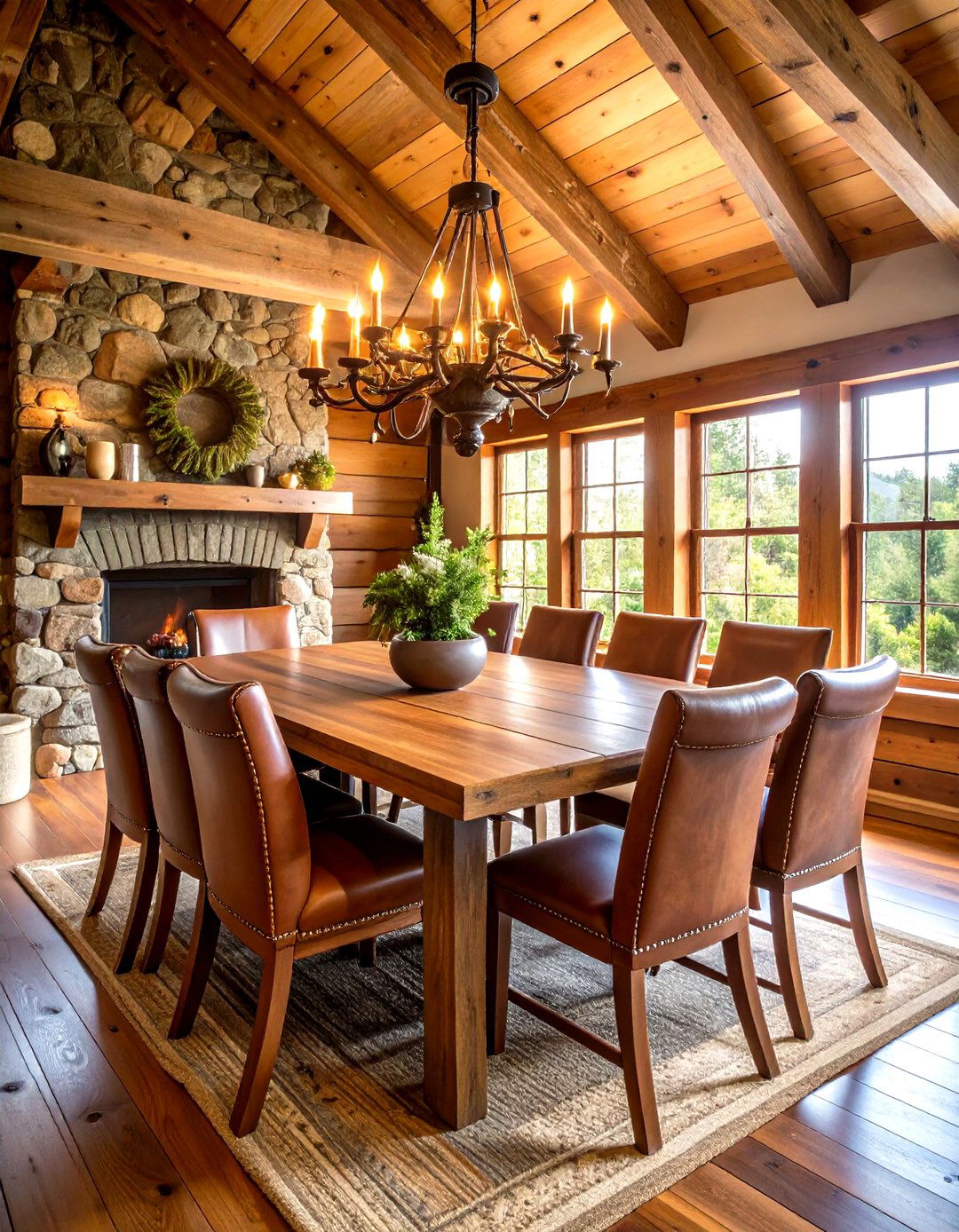
Design a warm, intimate space that captures the essence of mountain lodge living with rich wood tones and comfortable furnishings. Build the room around a solid pine or cedar dining table with natural edge details, surrounded by leather-upholstered chairs in deep brown or burgundy. Install log beam ceiling accents or full log walls to enhance the cabin atmosphere, complemented by a stone fireplace as a focal point. Choose warm lighting through antler chandeliers or rustic iron fixtures with amber glass shades. Layer the space with Native American-inspired textiles, including wool area rugs in earth tones and blanket throws draped over chair backs. Add natural elements like pinecone centerpieces, cedar branch arrangements, and mounted wildlife art. Complete the cozy retreat with knotty pine cabinetry for storage and display of rustic pottery and camping-themed accessories.
5. Exposed Beam Rustic Dining Room Cathedral
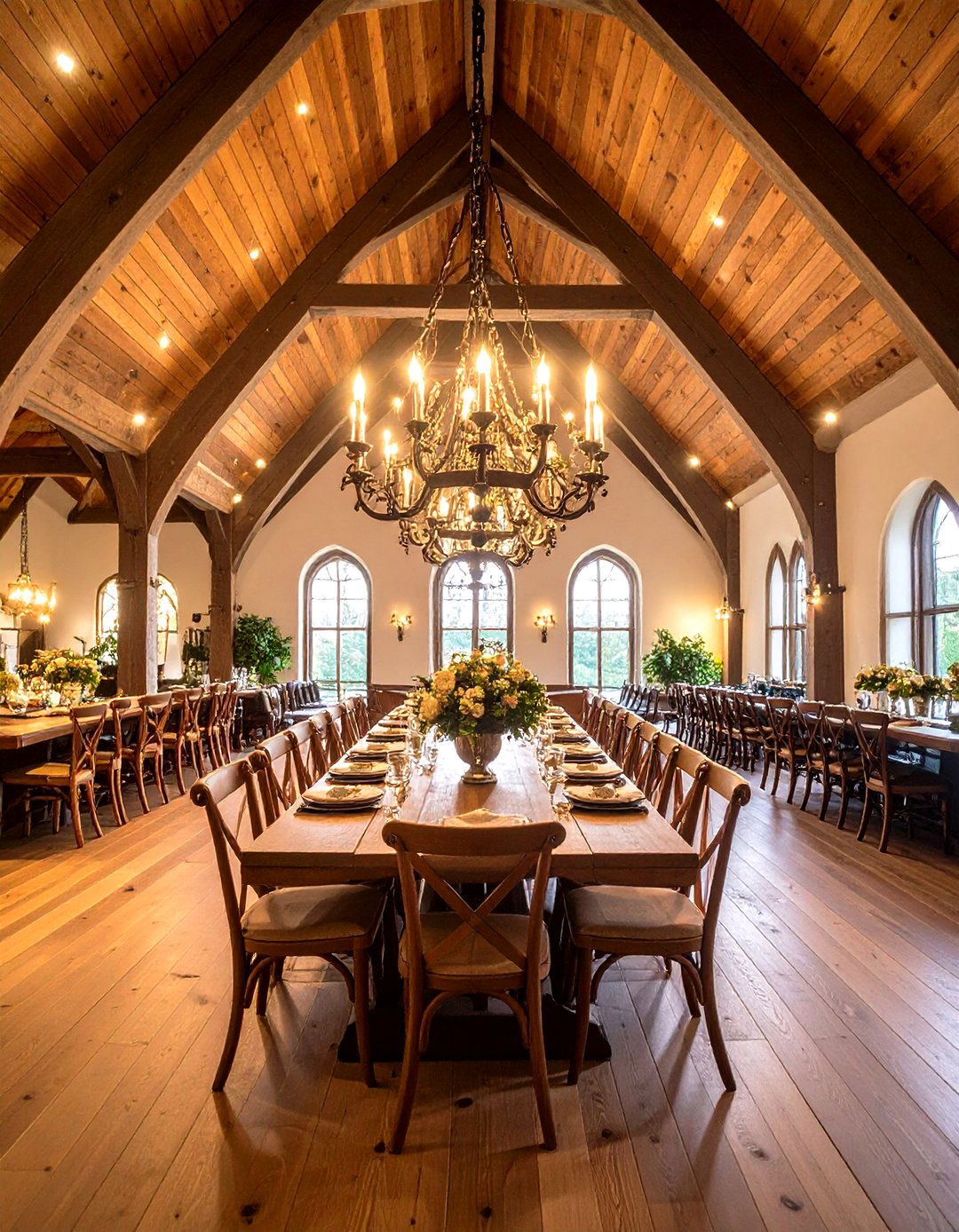
Create dramatic vertical space and architectural interest with soaring exposed beam ceilings that draw the eye upward in rustic grandeur. Install massive reclaimed timber beams in a cathedral or vaulted configuration, stained in rich walnut or left natural to showcase the wood's character. Position a long farmhouse table parallel to the beam pattern, crafted from matching wood species to create visual continuity throughout the space. Choose seating that complements the grand scale, such as high-back wooden chairs with rush seats or upholstered parsons chairs in neutral fabrics. Suspend oversized lighting fixtures from the peak beams, such as wrought iron chandeliers or clustered pendant lights. Enhance the cathedral feeling with tall windows featuring natural wood frames and minimal treatments. Add rustic storage through built-in hutches with cathedral-style arched doors, completing this majestic dining environment that celebrates craftsmanship and natural materials.
6. Stone and Timber Rustic Dining Room Fortress

Combine the rugged beauty of natural stone with warm timber elements to create a dining space that feels both substantial and inviting. Feature a stone accent wall behind a built-in dining banquette with thick wooden cushions covered in durable leather or canvas. Center the room with a live-edge wooden table supported by stone pedestals or timber trestle legs. Install exposed wooden ceiling beams while leaving stone walls natural or whitewashed for lighter ambiance. Choose lighting that complements both materials, such as iron and wood chandeliers or stone-based table lamps. Incorporate a stone fireplace with a massive wooden mantel for warmth and ambiance during gatherings. Add rustic charm through wooden serving pieces, stone pottery, and iron accessories. Complete the fortress-like atmosphere with slate or stone tile flooring, wooden window shutters, and heavy wooden furniture pieces that emphasize the room's substantial, permanent character.
7. Vintage Farmhouse Rustic Dining Room Collection
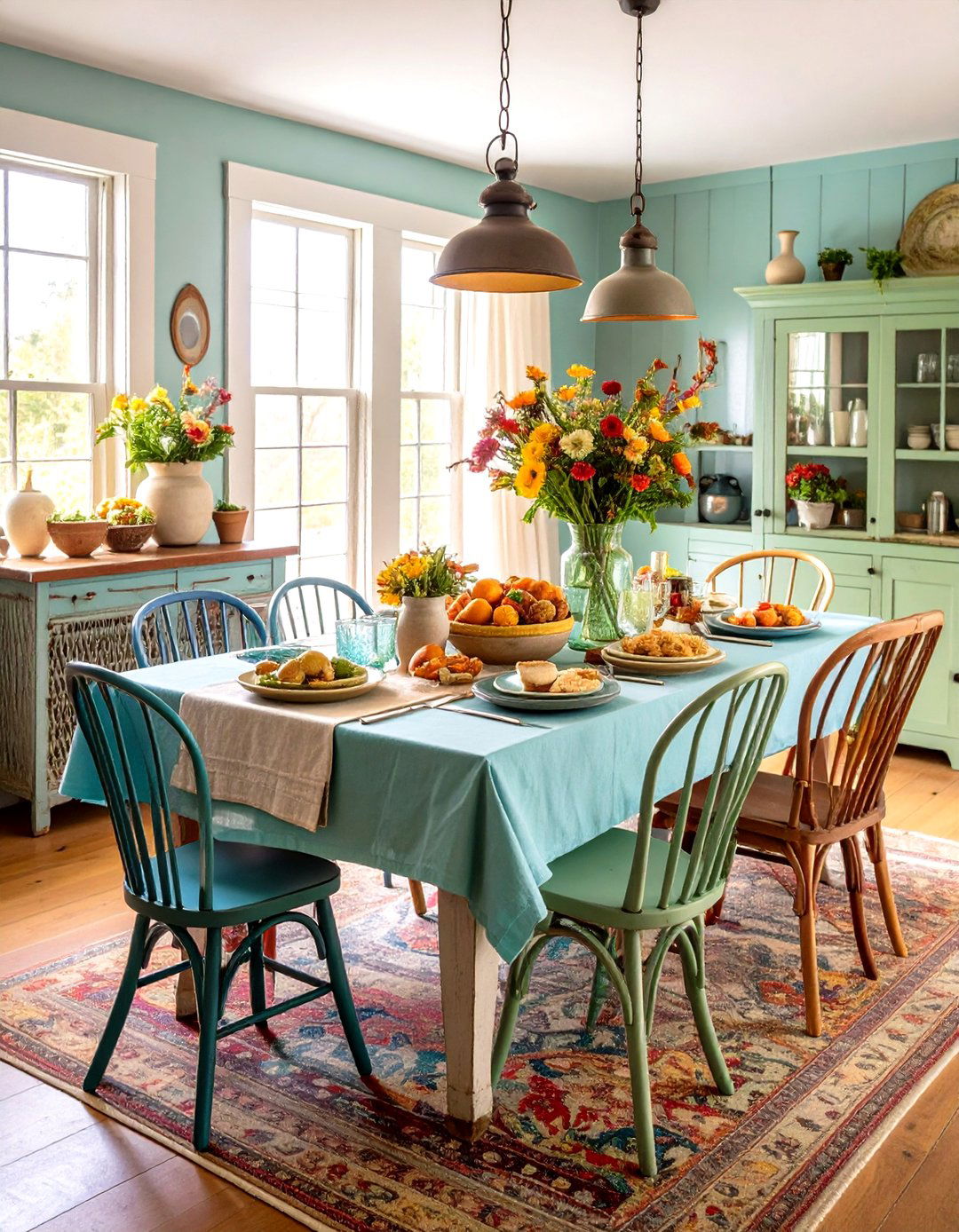
Celebrate nostalgic charm by curating authentic vintage pieces that tell the story of rural American life through carefully collected furnishings. Anchor the space with a genuine antique farmhouse table showing decades of family use, surrounded by mismatched vintage chairs sourced from different eras and styles. Display collections of vintage mason jars, milk glass, and depression-era glassware in restored chicken coop wire cabinets or pie safes. Install period-appropriate lighting such as schoolhouse pendant lights or converted oil lamp chandeliers with milk glass shades. Create vignettes with vintage farm tools, old scales, and weathered wooden signs advertising rural products. Layer vintage textiles including feed sack curtains, quilted table runners, and doilies as placemats. Paint walls in heritage colors like barn red, sage green, or cream, and finish with wide-plank flooring in weathered pine. This authentic approach creates a museum-quality dining room celebrating rural heritage.
8. Sliding Barn Door Rustic Dining Room Gateway
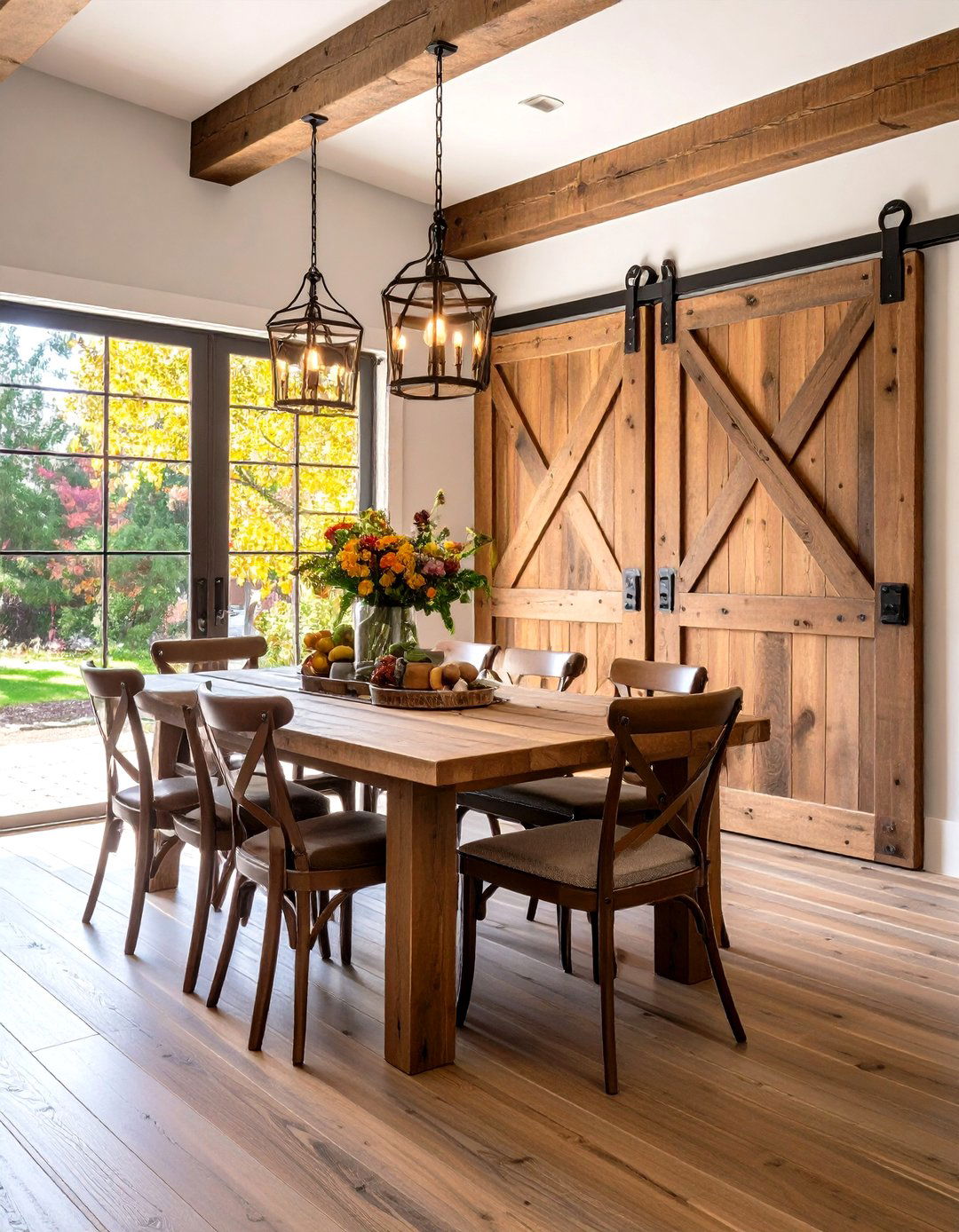
Make a bold architectural statement with oversized sliding barn doors that serve as both functional room dividers and striking design elements. Install massive reclaimed wood doors on industrial track hardware, allowing the dining room to be opened to or closed off from adjacent living spaces. Choose doors with traditional X-bracing, vertical plank construction, or modern interpretations featuring glass panels for light transmission. Complement the doors with matching wood elements throughout the dining space, including a coordinating table, ceiling beams, and built-in storage. Paint the doors in statement colors like deep navy, forest green, or classic barn red to create focal points, or leave them natural to showcase beautiful wood grain. Add period-appropriate hardware including iron handles, slide bolts, and decorative hinges. Complete the barn-inspired theme with galvanized metal accessories, vintage farm implements as wall art, and industrial-style lighting fixtures that echo the door hardware.
9. Neutral Palette Rustic Dining Room Sanctuary
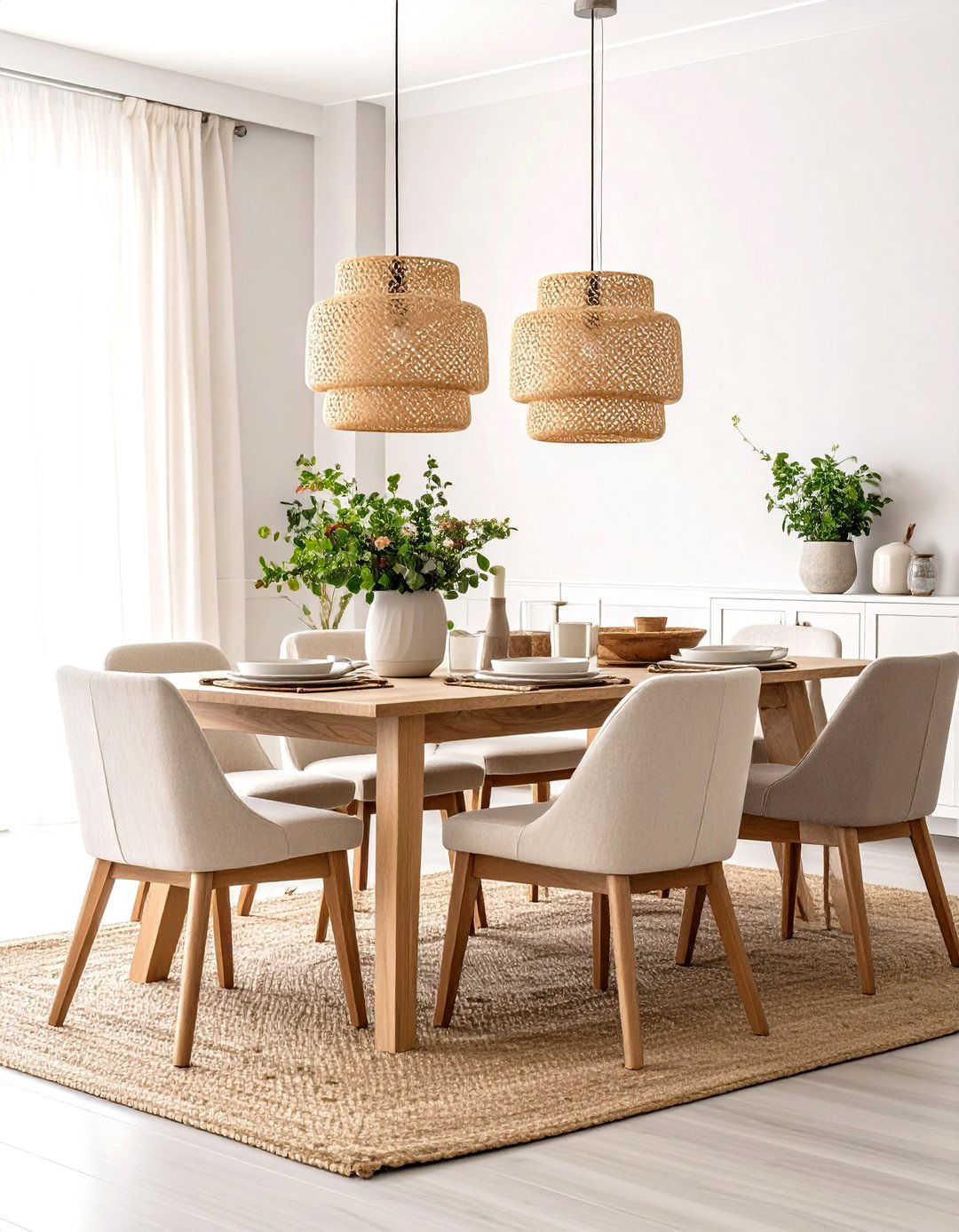
Create a serene, spa-like atmosphere using a sophisticated neutral color scheme that celebrates natural textures and organic materials. Build the design around a bleached or whitewashed wooden dining table paired with linen-upholstered chairs in soft cream, taupe, and gray tones. Paint walls in warm white or pale gray, adding visual interest through natural wood wainscoting or board-and-batten paneling in the same neutral family. Choose lighting fixtures in brushed nickel or aged brass finishes, such as linear chandeliers with linen drum shades or clustered glass pendant lights. Layer textures through jute area rugs, linen table runners, and woven baskets in natural fibers. Incorporate subtle pattern through striped or check fabrics in muted tones. Add organic elements like driftwood centerpieces, white ceramic pottery, and fresh greenery in neutral planters. This calming approach creates a timeless dining environment that feels both rustic and refined.
10. Open Concept Rustic Dining Room Integration
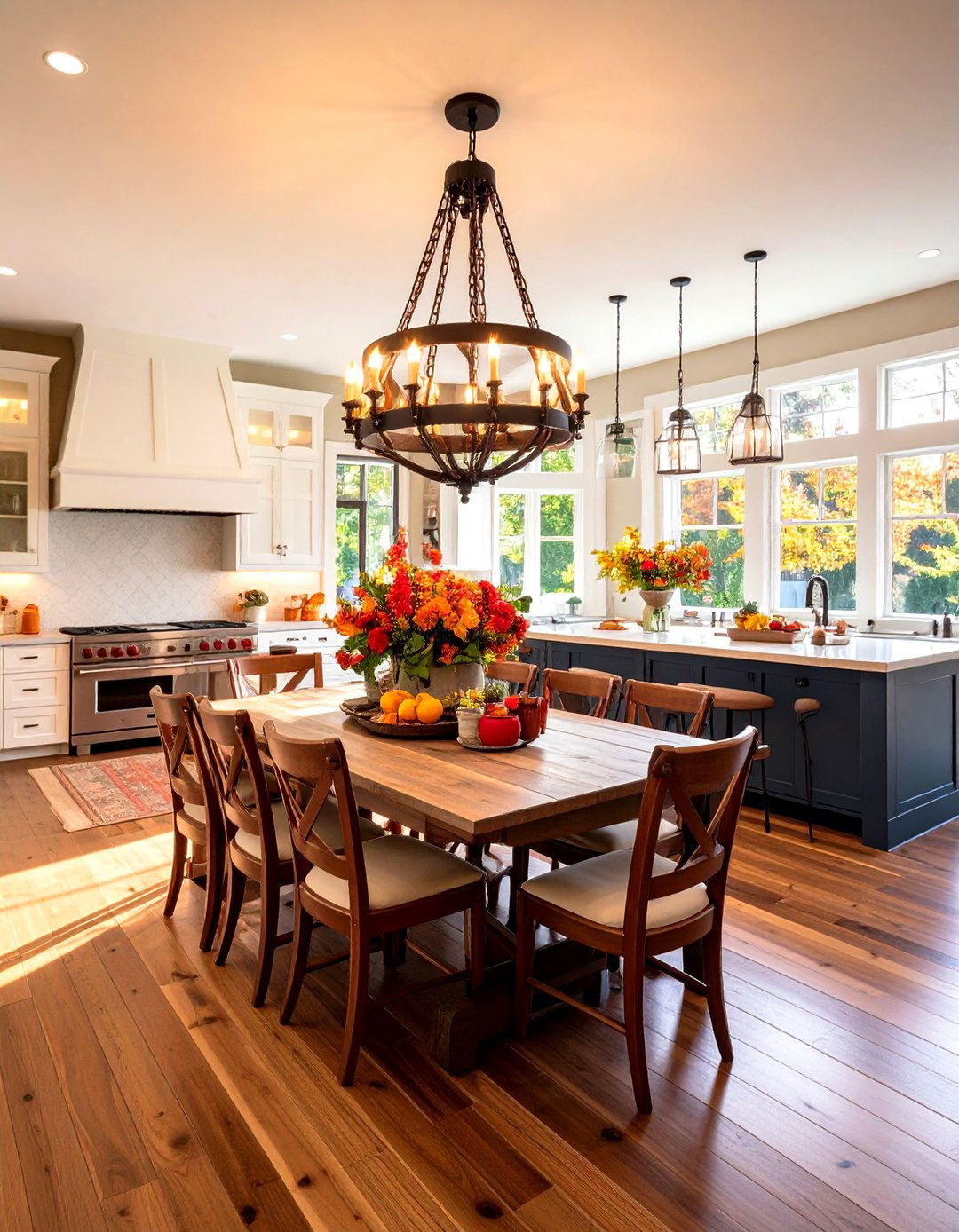
Design a seamless flow between kitchen, dining, and living areas while maintaining distinct rustic character in each zone through thoughtful material coordination. Use consistent flooring throughout, such as wide-plank hardwood or distressed oak, to unify the spaces visually. Define the dining area with a statement light fixture like a wagon wheel chandelier or industrial pipe pendant cluster suspended over a central farmhouse table. Create subtle boundaries through furniture placement, area rugs, and varying ceiling treatments while maintaining sightlines between spaces. Install a large kitchen island with seating that extends the dining functionality, using matching wood species and finishes throughout. Add rustic elements consistently across zones, including exposed beams, shiplap accents, and vintage accessories. Incorporate a stone fireplace visible from multiple areas to serve as a central focal point. This integrated approach creates a cohesive rustic environment perfect for entertaining and family gatherings.
11. Rustic Dining Room Hutch and Storage Showcase
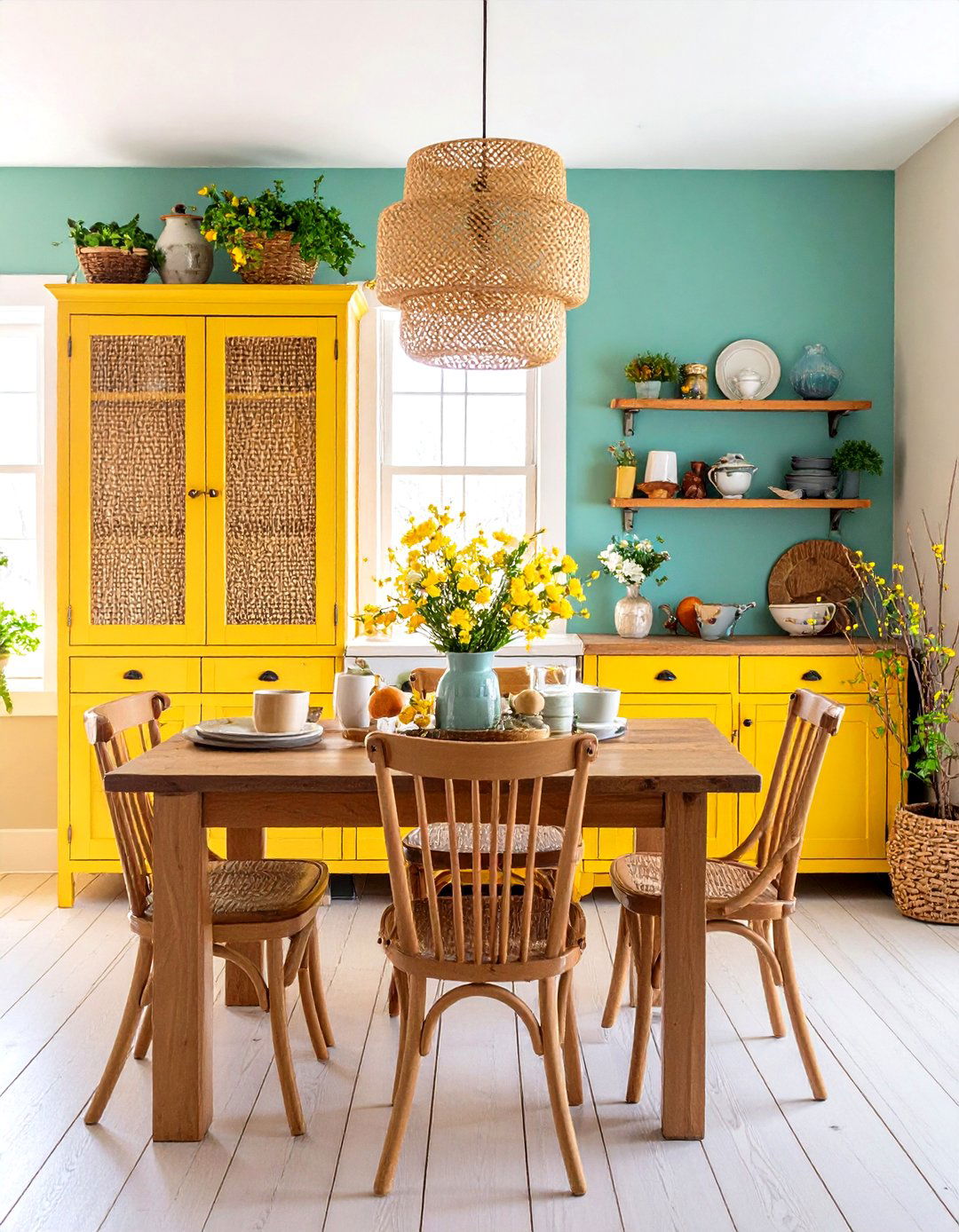
Maximize both function and style with comprehensive built-in storage solutions that display treasured collections while maintaining rustic authenticity. Design a full wall of rustic cabinetry featuring chicken wire or glass-front upper cabinets for displaying vintage china, mason jar collections, and seasonal decorative items. Include lower cabinets with distressed paint finishes in classic farmhouse colors like sage green, cream, or barn red. Incorporate open shelving sections for storing baskets, serving pieces, and cookbooks. Add a serving counter area with butcher block tops for food preparation and buffet service. Install period-appropriate hardware including bin pulls, cup hinges, and iron latches. Crown the storage wall with natural wood beams or decorative cornices. Complete the functional design with interior cabinet lighting, plate grooves for display, and wine storage cubbies. This comprehensive storage approach combines practical organization with authentic rustic character that enhances the dining experience.
12. Rustic Dining Room Fireplace Hearth Center
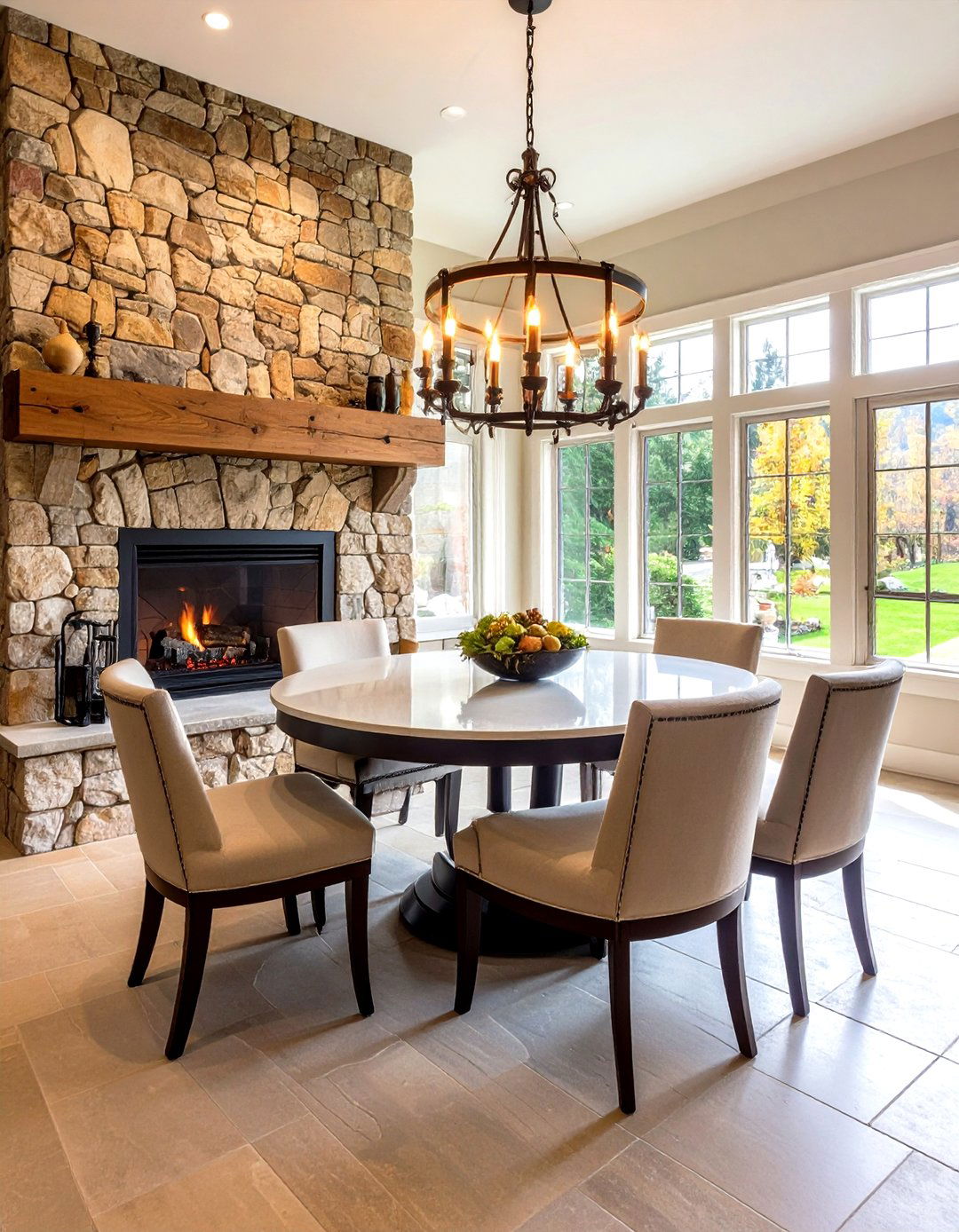
Create an intimate gathering space centered around a commanding stone or brick fireplace that serves as both warmth source and architectural focal point. Position the dining table to take advantage of the fireplace ambiance, choosing a round or oval table to encourage conversation around the hearth. Build rustic seating arrangements including a cushioned stone hearth bench, ladder-back chairs, and a wooden settle or church pew. Install a massive wooden mantel from reclaimed barn beams, styling it with vintage lanterns, seasonal greenery, and rustic pottery. Choose complementary materials throughout, including stone tile or brick flooring that extends from the fireplace area. Add cozy lighting through iron sconces flanking the fireplace and overhead fixtures that complement the hearth's rustic character. Layer textiles including wool throws, braided rugs, and heavy curtains that enhance the room's warmth. Complete the hearth-centered design with wrought iron fireplace tools, copper kettles, and other authentic accessories that celebrate traditional craftsmanship.
13. Rustic Dining Room Garden Connection Paradise
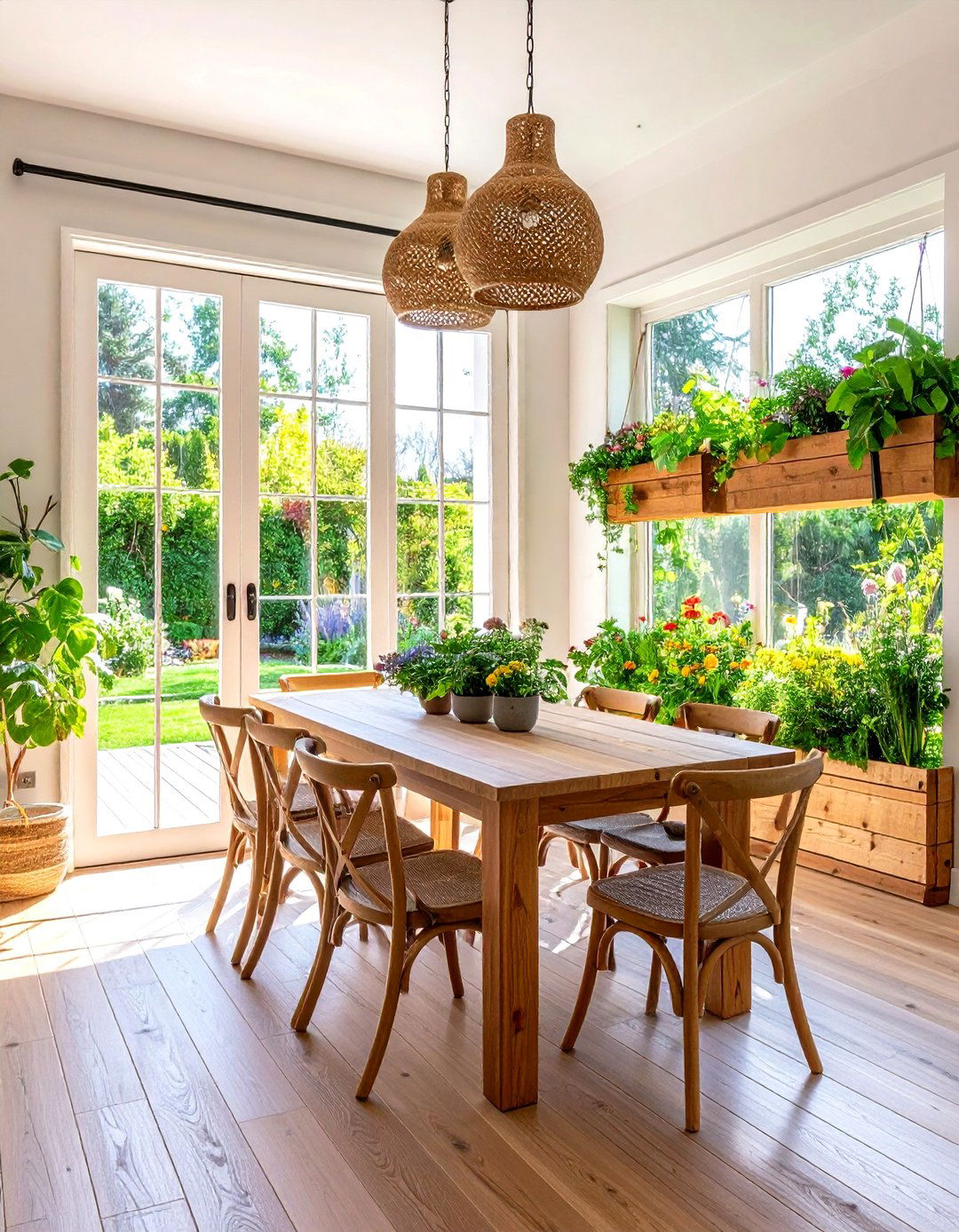
Blur the boundaries between indoor and outdoor spaces by creating seamless connections to gardens, patios, and natural landscapes through rustic design elements. Install large French doors or sliding glass panels that open completely to outdoor dining areas, using matching furniture and materials inside and out. Choose weather-resistant rustic furniture like teak farmhouse tables and metal chairs that can transition between spaces. Bring garden elements indoors through herb gardens in wooden window boxes, seasonal flower arrangements in galvanized containers, and potted plants throughout the dining space. Install natural materials like flagstone flooring that continues outdoors, creating visual flow between spaces. Add rustic touches through vintage garden tools as wall art, antique watering cans as vases, and farm-style lighting that works in both environments. Include practical elements like mudrooms or boot storage areas near garden entrances. This garden-connected approach creates year-round enjoyment of natural beauty while dining.
14. Rustic Dining Room Chandelier Statement Drama
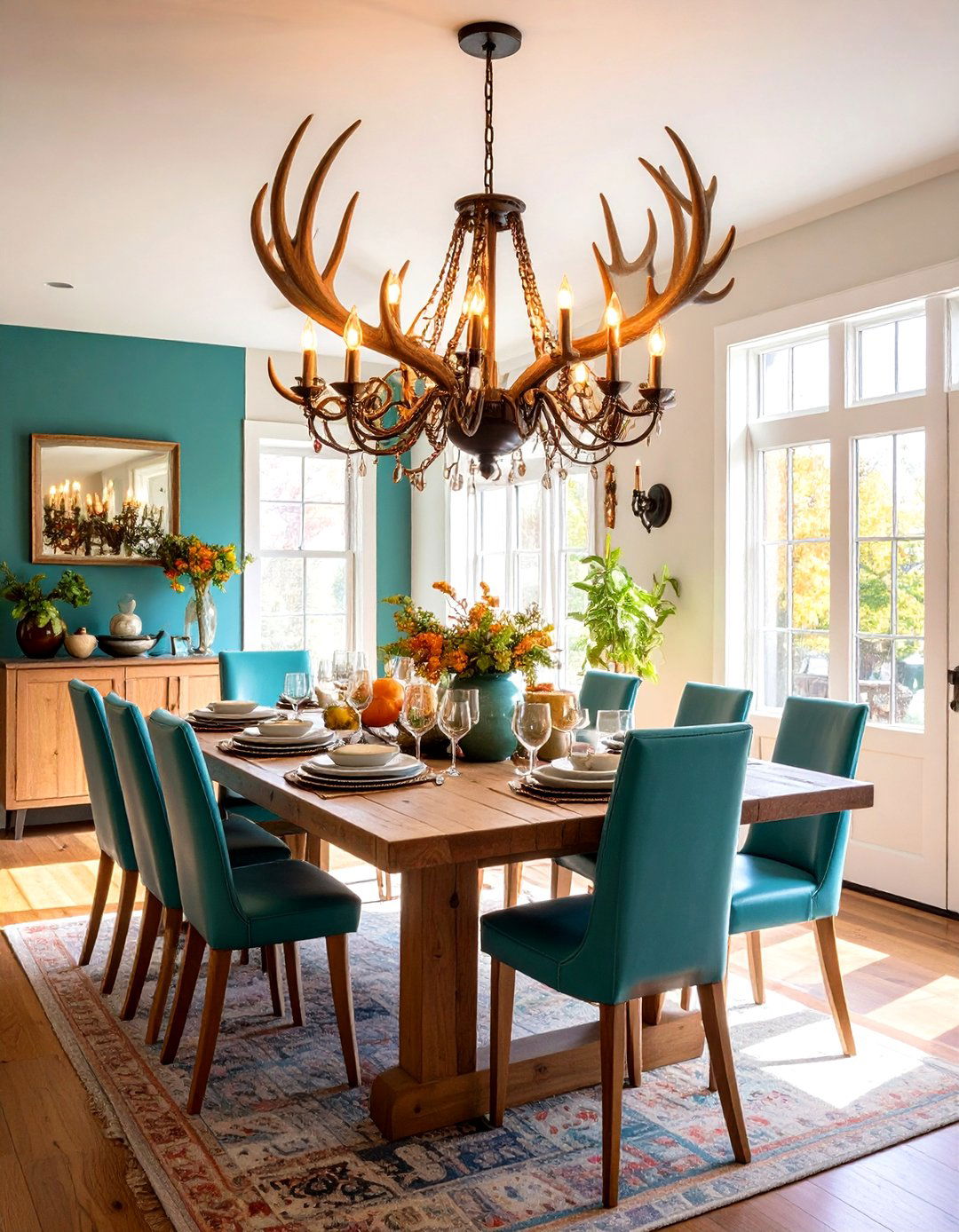
Make lighting the star attraction with oversized, dramatic chandeliers that command attention and define the rustic dining experience. Choose grand fixtures like antler chandeliers, wrought iron masterpieces, or wagon wheel designs with multiple candle-style bulbs that provide both illumination and artistic impact. Scale the chandelier appropriately for the table size and ceiling height, ensuring adequate clearance while maximizing visual presence. Complement the statement lighting with coordinating sconces, pendant lights over a kitchen island, or table lamps on sideboards. Choose chandelier materials that echo throughout the room, such as matching iron cabinet hardware, metal chair frames, or decorative accessories. Install dimmer controls to adjust ambiance from bright task lighting for meals to soft romantic glow for entertaining. Add reflective elements like mirrors, metallic accessories, or glass collections that enhance the chandelier's light distribution. This lighting-focused approach creates memorable dining experiences centered around spectacular illumination.
15. Mixed Material Rustic Dining Room Texture Festival
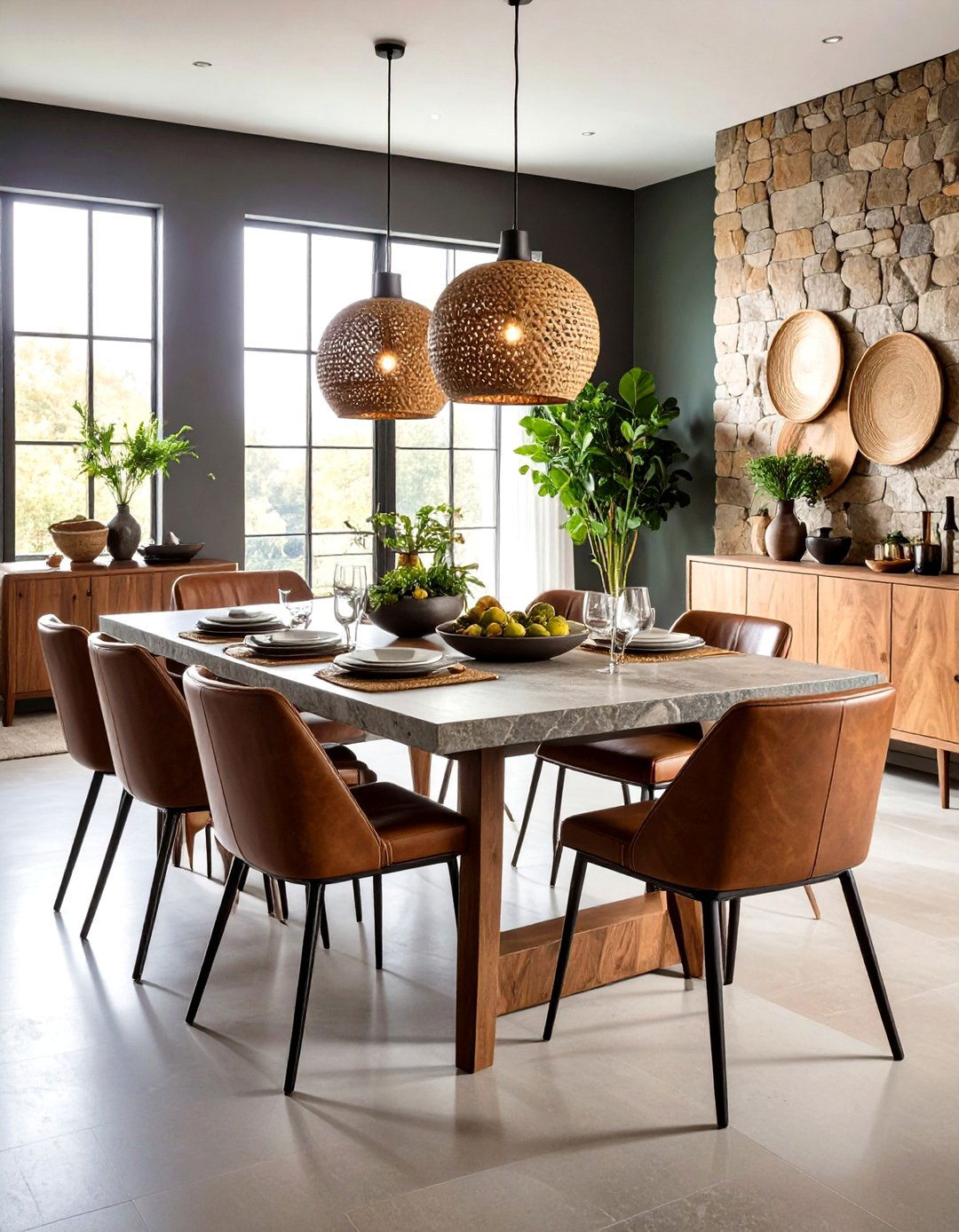
Celebrate the beauty of contrasting textures by thoughtfully combining wood, metal, stone, and fabric elements in a harmonious rustic composition. Start with a dining table featuring mixed materials like a stone top with wooden base, metal legs with reclaimed wood surface, or live-edge wood with industrial steel supports. Choose seating that incorporates multiple textures, such as leather chairs with metal frames, wooden benches with fabric cushions, or wicker seats with iron backs. Add textural variety through wall treatments including stone accent walls, wooden paneling, and fabric wall coverings in natural fibers. Layer flooring materials like stone tile with wooden transitions, area rugs over hardwood, or brick with soft textile runners. Include accessories that showcase different textures: woven baskets, hammered metal serving pieces, rough pottery, and smooth glass collections. This multi-textural approach creates rich, tactile environments that invite touch and provide visual interest from every angle.
16. Rustic Dining Room Window Treatment Softness
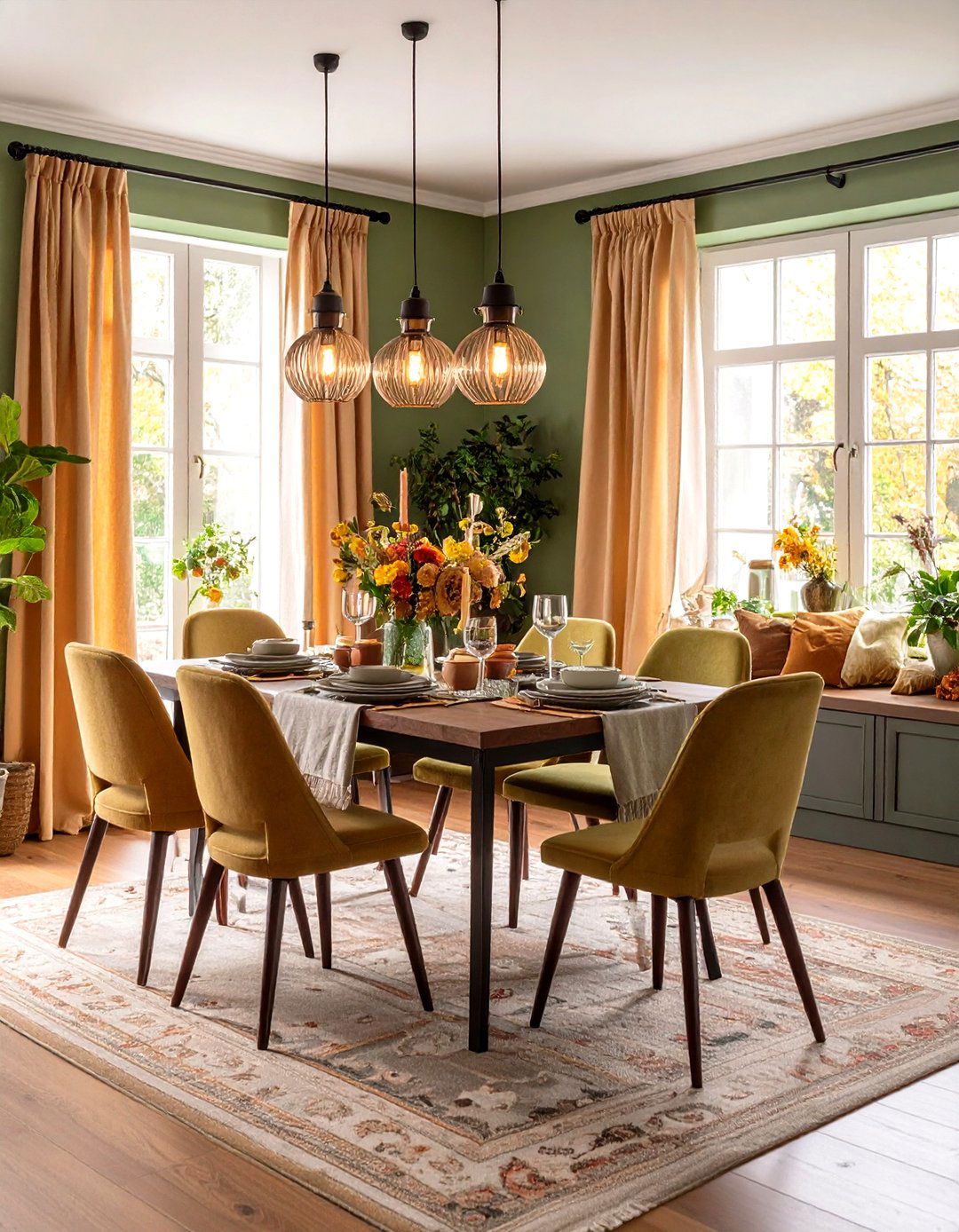
Frame spectacular views and control natural light through rustic window treatments that add softness while maintaining the room's authentic character. Install natural linen curtains in neutral tones, hung from iron rods with decorative finials that complement other metal elements in the space. Choose treatments that showcase texture, such as burlap panels, woven hemp fabrics, or vintage grain sack materials with subtle stripes or checks. Add functional elements like wooden shutters, bamboo blinds, or matchstick shades that filter light while preserving privacy. Layer window treatments for versatility, combining sheers with heavier panels or blinds with decorative valances. Include window seat areas with built-in storage and cushions covered in rustic fabrics like leather, canvas, or wool. Add window boxes for herbs or seasonal plants that create living curtains of greenery. Complete the soft treatment approach with coordinating table linens, chair cushions, and throw pillows that unify the room's textile elements.
17. Rustic Dining Room Bench Seating Community Style
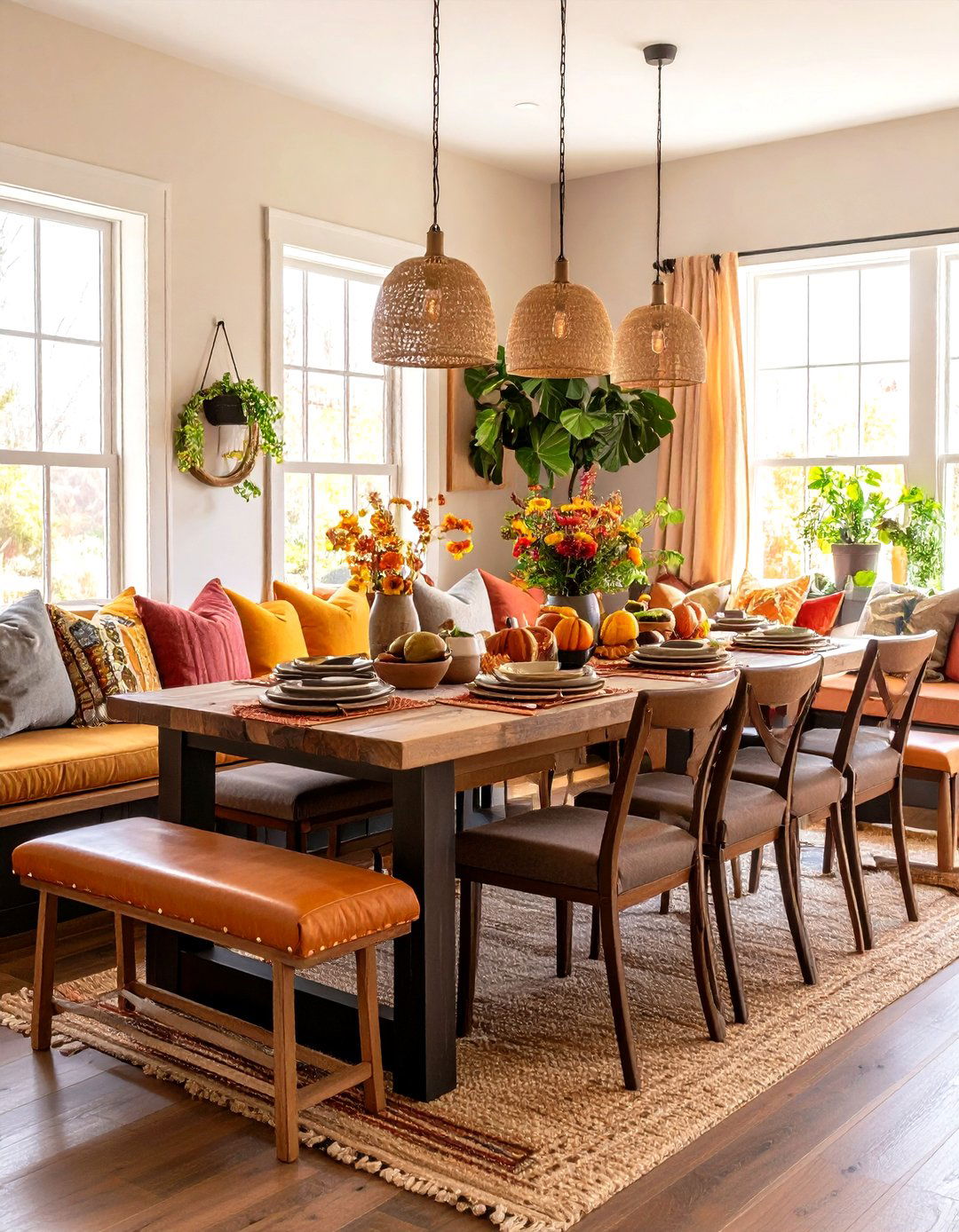
Foster intimate gatherings and flexible seating through rustic bench arrangements that encourage closeness and accommodate varying group sizes. Design built-in bench seating along walls or windows, using reclaimed wood construction with comfortable cushions covered in durable fabrics like leather, canvas, or wool. Add freestanding benches that can move throughout the space for different occasions, choosing designs with storage compartments, curved backs, or trestle construction. Mix bench seating with traditional chairs to create varied seating heights and visual interest around the dining table. Include corner bench arrangements that maximize seating in compact spaces, adding throw pillows and blankets for comfort. Choose bench styles that reflect the room's overall character, such as church pew benches for traditional settings, live-edge slabs for natural environments, or painted benches for farmhouse aesthetics. Complete the community-style seating with harvest tables, family-style serving pieces, and accessories that encourage shared meals and conversation.
18. Seasonal Rustic Dining Room Transformation Flexibility
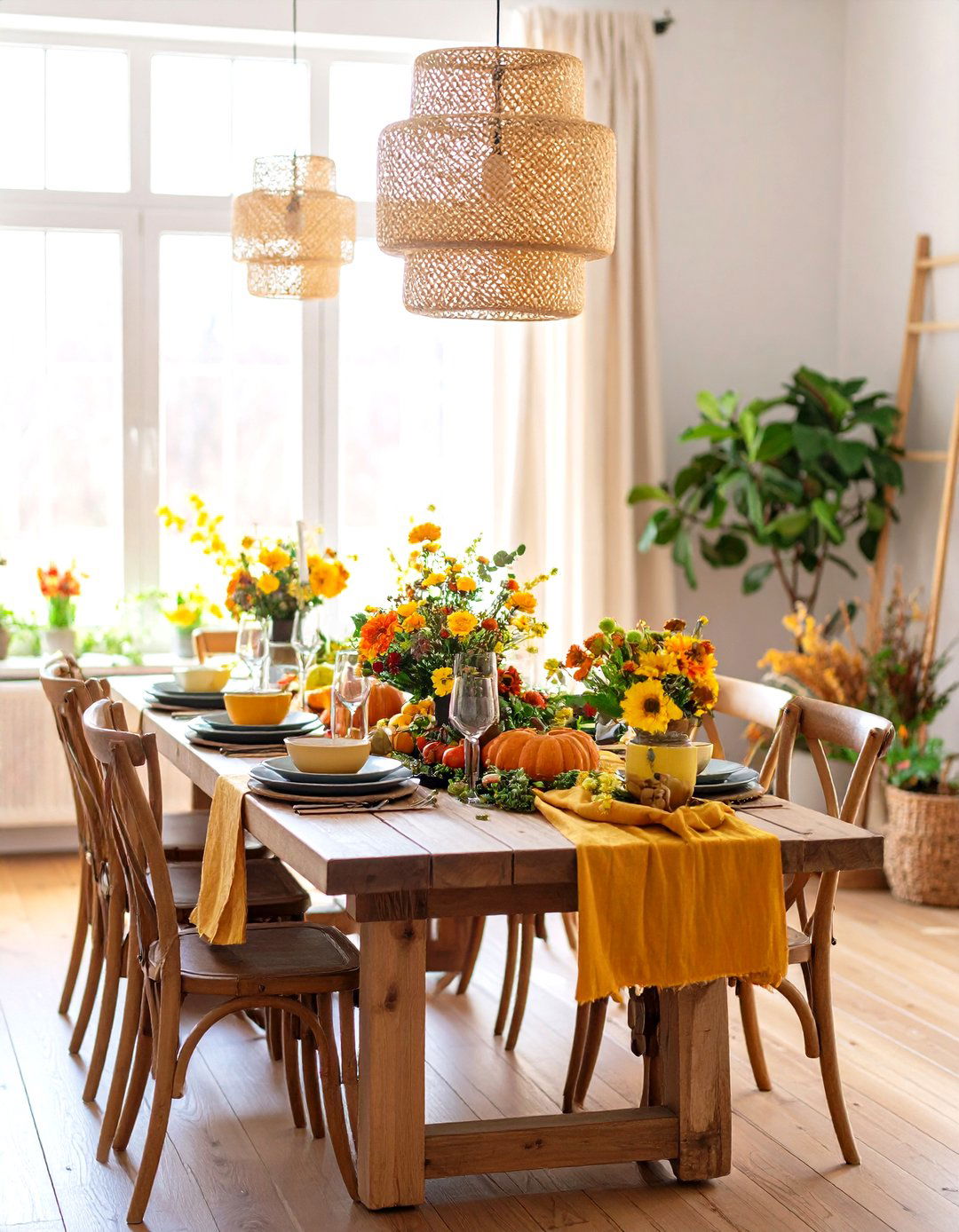
Create a dynamic dining environment that celebrates changing seasons through easily modified rustic elements and flexible decorating approaches. Design the foundation with timeless rustic pieces like farmhouse tables, wooden chairs, and neutral wall colors that work year-round. Add seasonal interest through changeable elements like table runners, centerpieces, and accessories that reflect natural cycles. Spring brings fresh greenery, pastel linens, and garden elements; summer features bright flowers, lightweight fabrics, and outdoor connections; autumn showcases harvest themes, warm colors, and cozy textiles; winter emphasizes evergreens, rich fabrics, and hearth-focused arrangements. Install flexible lighting systems that adjust for seasonal mood changes, from bright summer ambiance to cozy winter glow. Choose storage solutions that accommodate seasonal items, including built-in cabinets for holiday china, decorative containers for seasonal linens, and display areas for rotating collections. This adaptable approach keeps the dining room fresh and relevant throughout the year.
19. Rustic Dining Room Color Accent Bold Statement

Energize neutral rustic foundations with carefully chosen color accents that add personality while maintaining the space's natural character. Build the base design with classic rustic elements in neutral tones: natural wood furniture, cream or gray walls, and stone or brick accents that provide timeless appeal. Introduce bold color through painted furniture pieces like sage green hutches, navy blue chairs, or red benches that serve as focal points without overwhelming the space. Add colorful textiles including patterned curtains, vibrant area rugs, or seasonal table linens that can change with mood or occasion. Include artwork and accessories in coordinating accent colors, such as vintage signs, pottery collections, or metal accessories in complementary hues. Choose colors inspired by nature: deep forest greens, sunset oranges, sky blues, or earth-tone rusts that feel authentic to rustic environments. Balance bold accents with plenty of neutral space to prevent color overload while creating memorable visual impact.
20. Rustic Dining Room Vintage Lighting Time Travel

Transport diners to bygone eras through carefully curated vintage lighting fixtures that provide both illumination and historical character. Seek authentic antique pieces like converted oil lamps, schoolhouse pendant lights, or farmhouse chandeliers with milk glass shades that tell stories of rural life. Include table lamps with vintage character, such as mason jar conversions, old lanterns wired for electricity, or repurposed farm equipment turned into unique lighting fixtures. Mix lighting types for layered illumination: overhead fixtures for general lighting, task lighting for food service, and accent lighting for ambiance. Choose fixtures with period-appropriate materials like brass, copper, iron, or tin that develop beautiful patina over time. Install traditional-style switches and outlet covers that maintain historical accuracy throughout the space. Add candle lighting through vintage candelabras, hurricane lamps, or wall sconces for ultimate romantic ambiance. This vintage lighting approach creates dining experiences that feel like steps back in time while providing modern functionality.
Conclusion:
Rustic dining rooms offer endless opportunities to create warm, inviting spaces that celebrate natural materials and timeless design principles. Whether embracing authentic farmhouse traditions or modern interpretations of rustic style, these ideas demonstrate how thoughtful material choices, strategic lighting, and carefully curated accessories can transform any dining space into a welcoming retreat. The key lies in balancing functionality with character, ensuring each element serves both practical and aesthetic purposes. By incorporating these comprehensive design themes, homeowners can create dining environments that encourage lingering conversations, memorable meals, and cherished family traditions for generations to come.


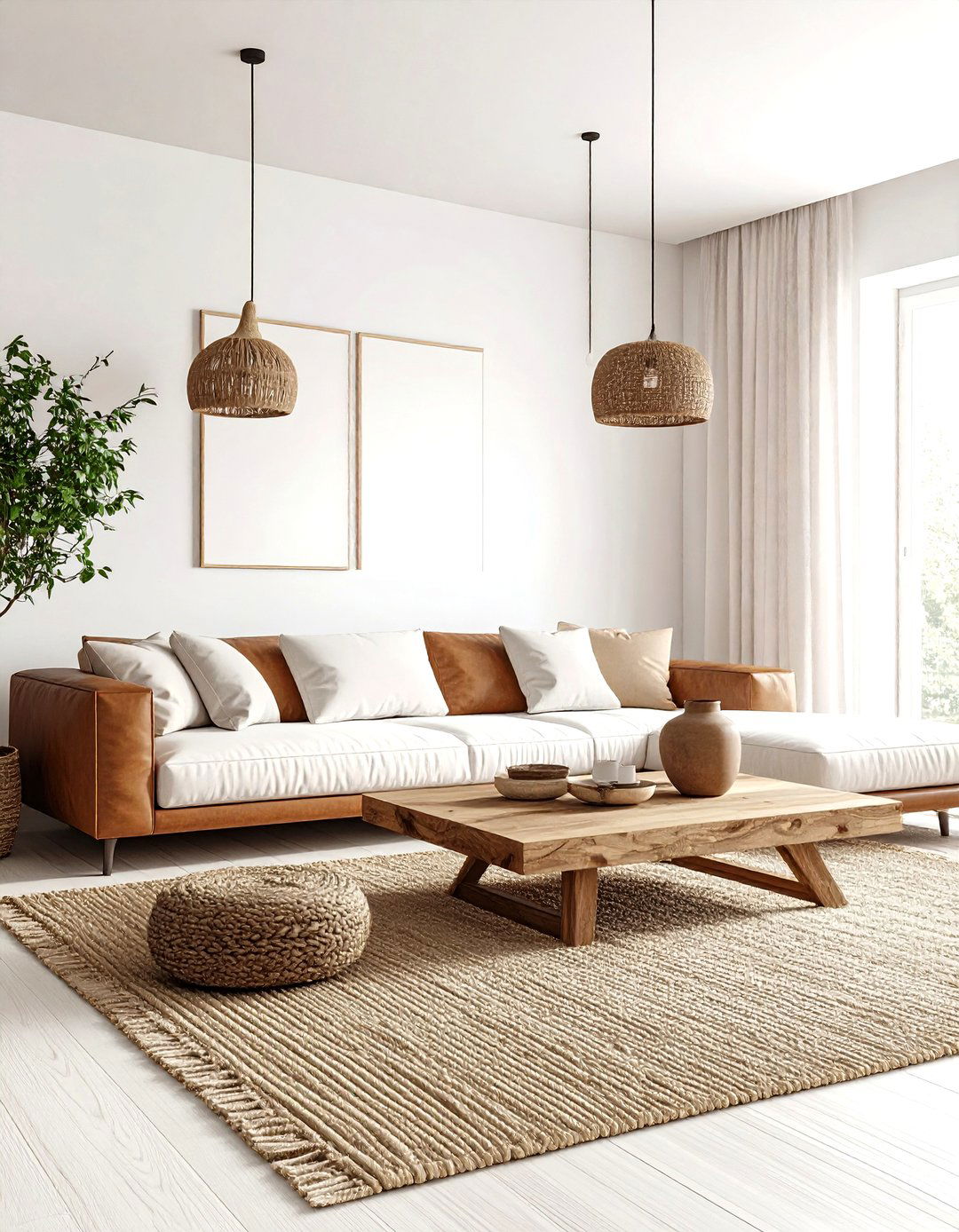
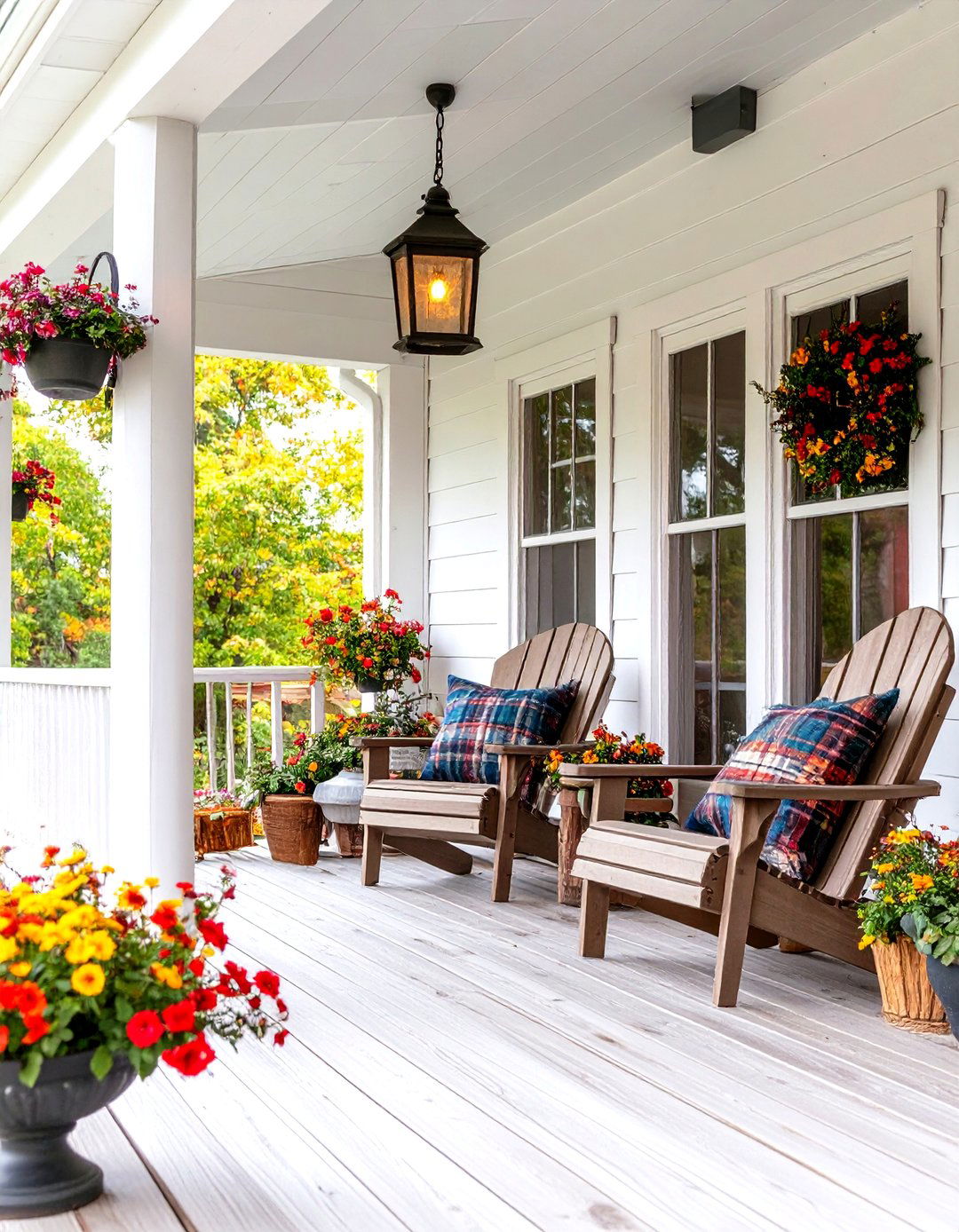
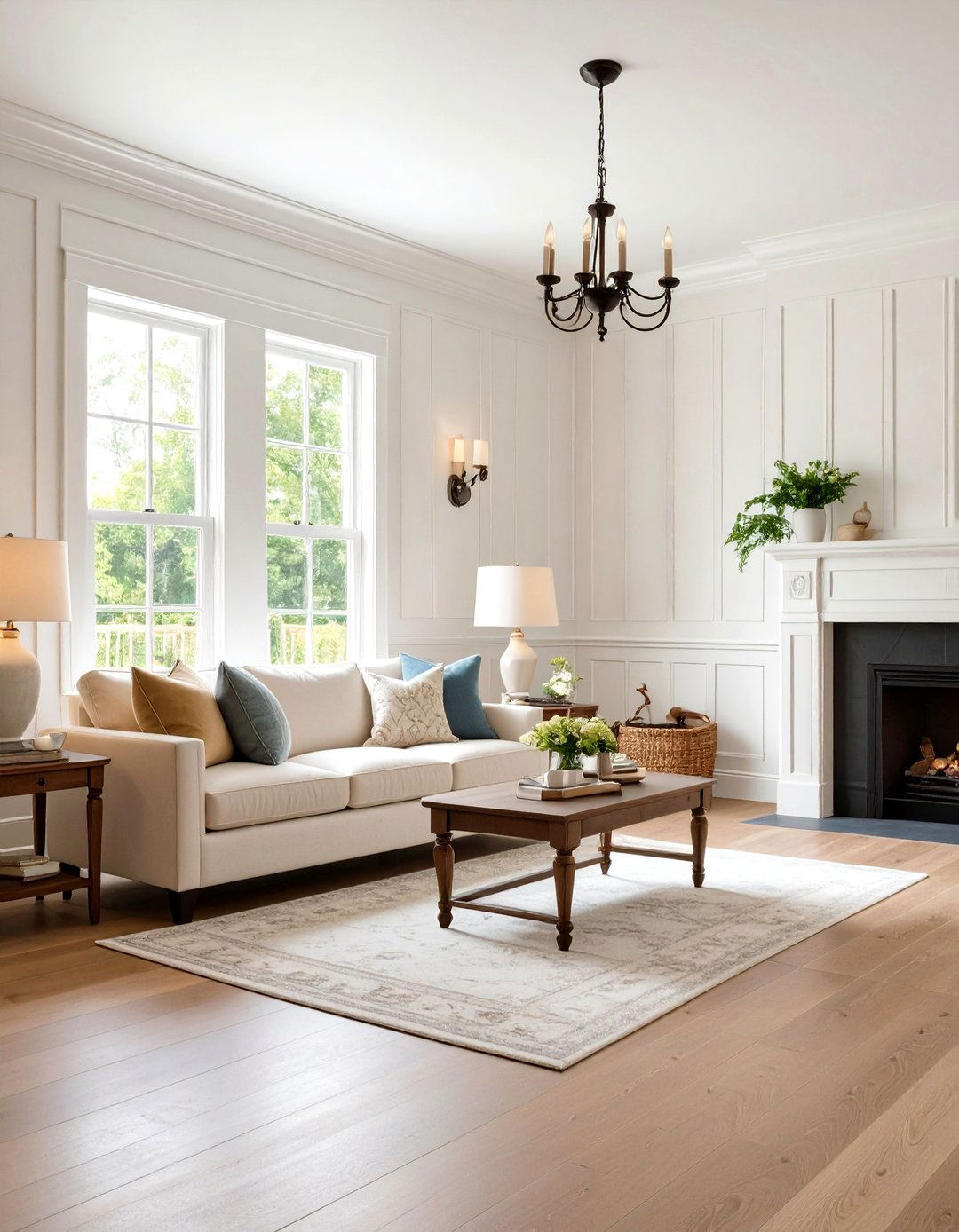
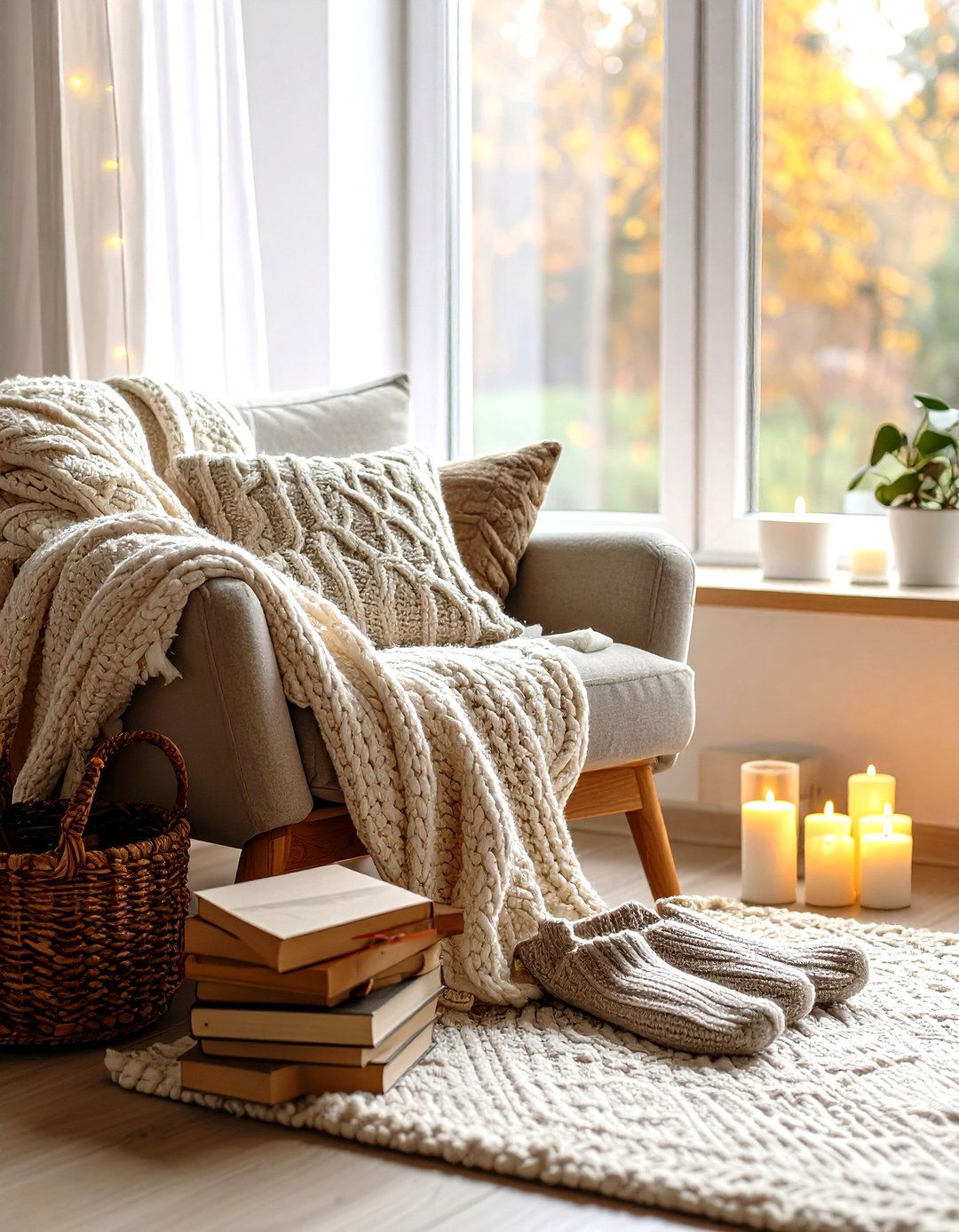

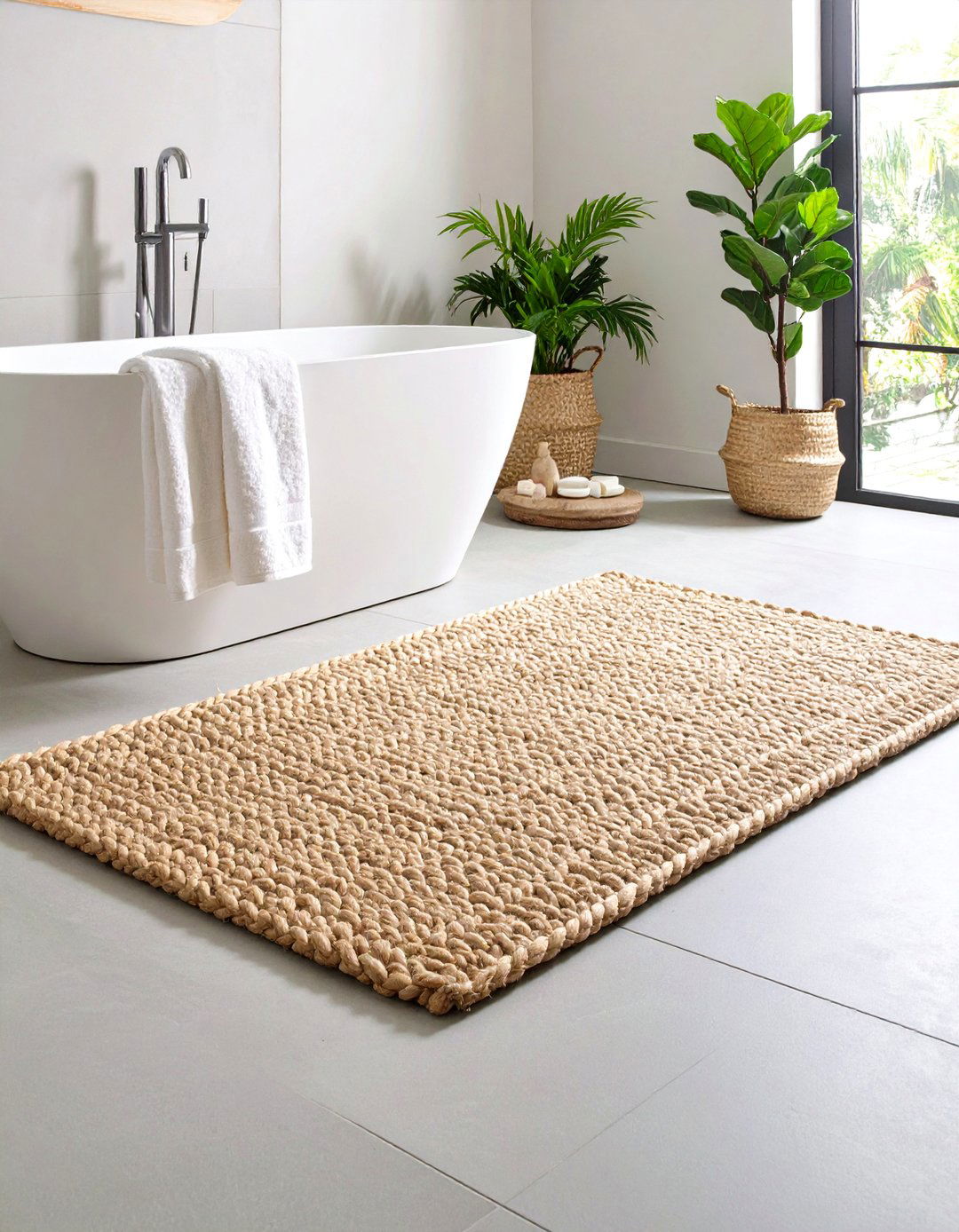
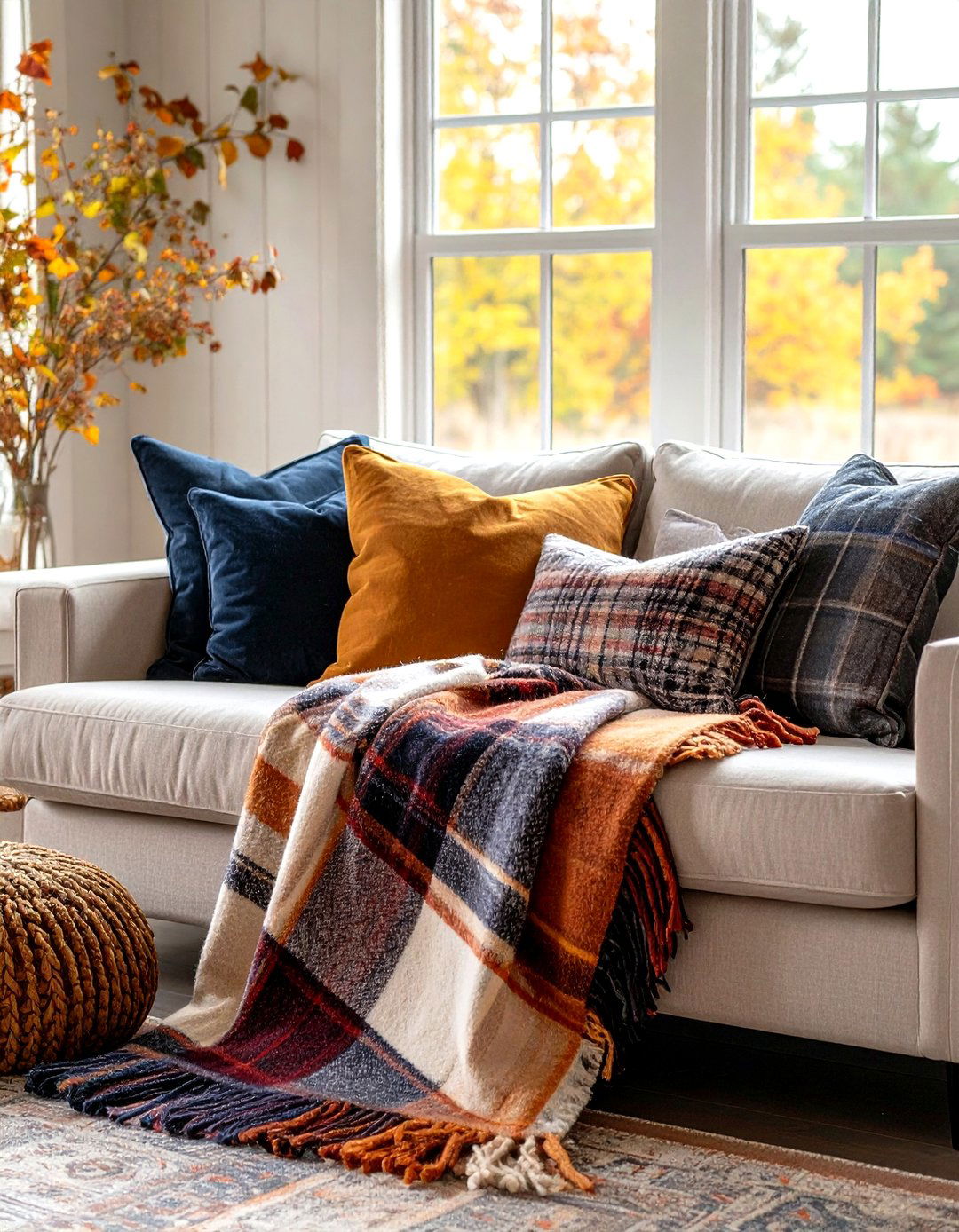
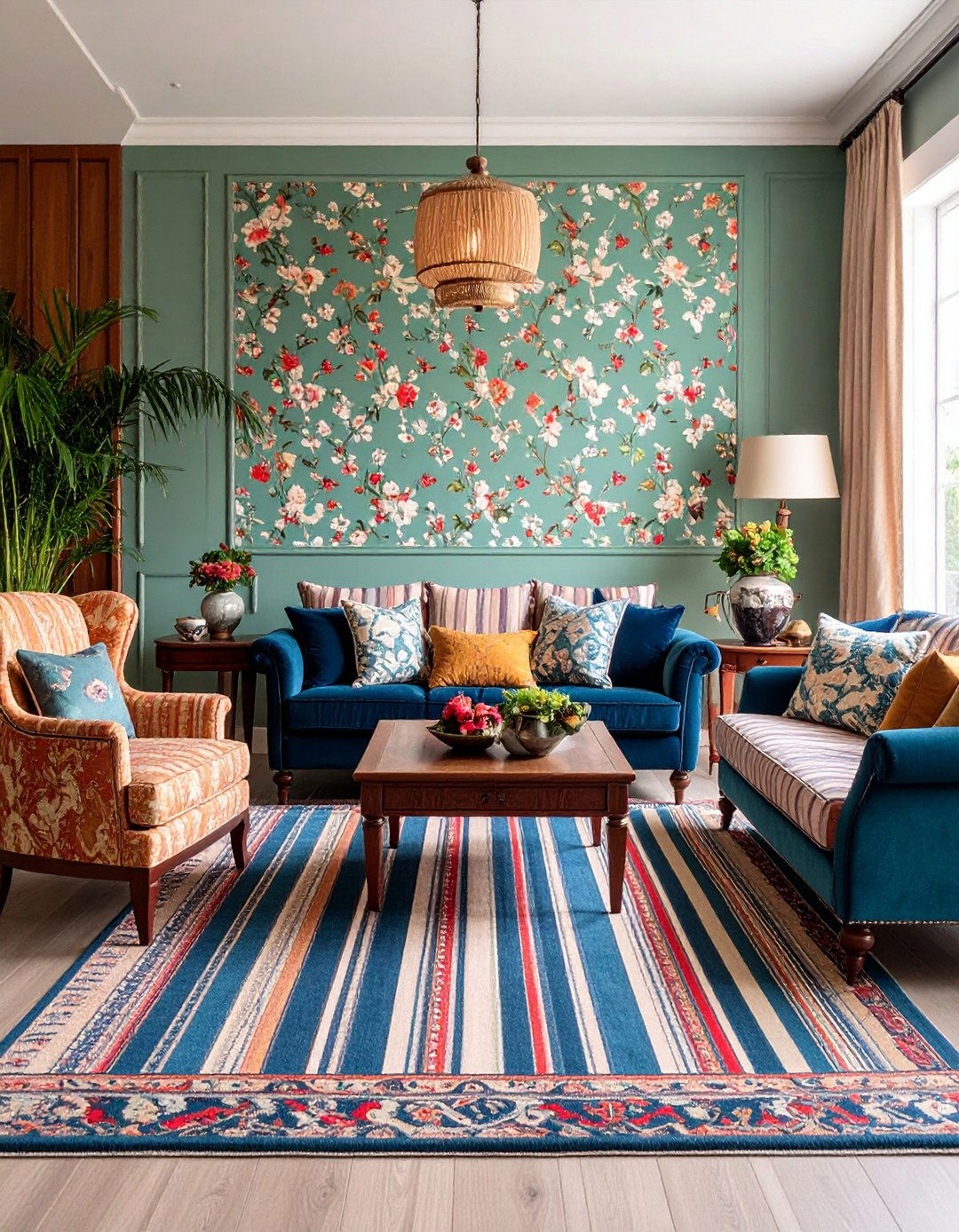
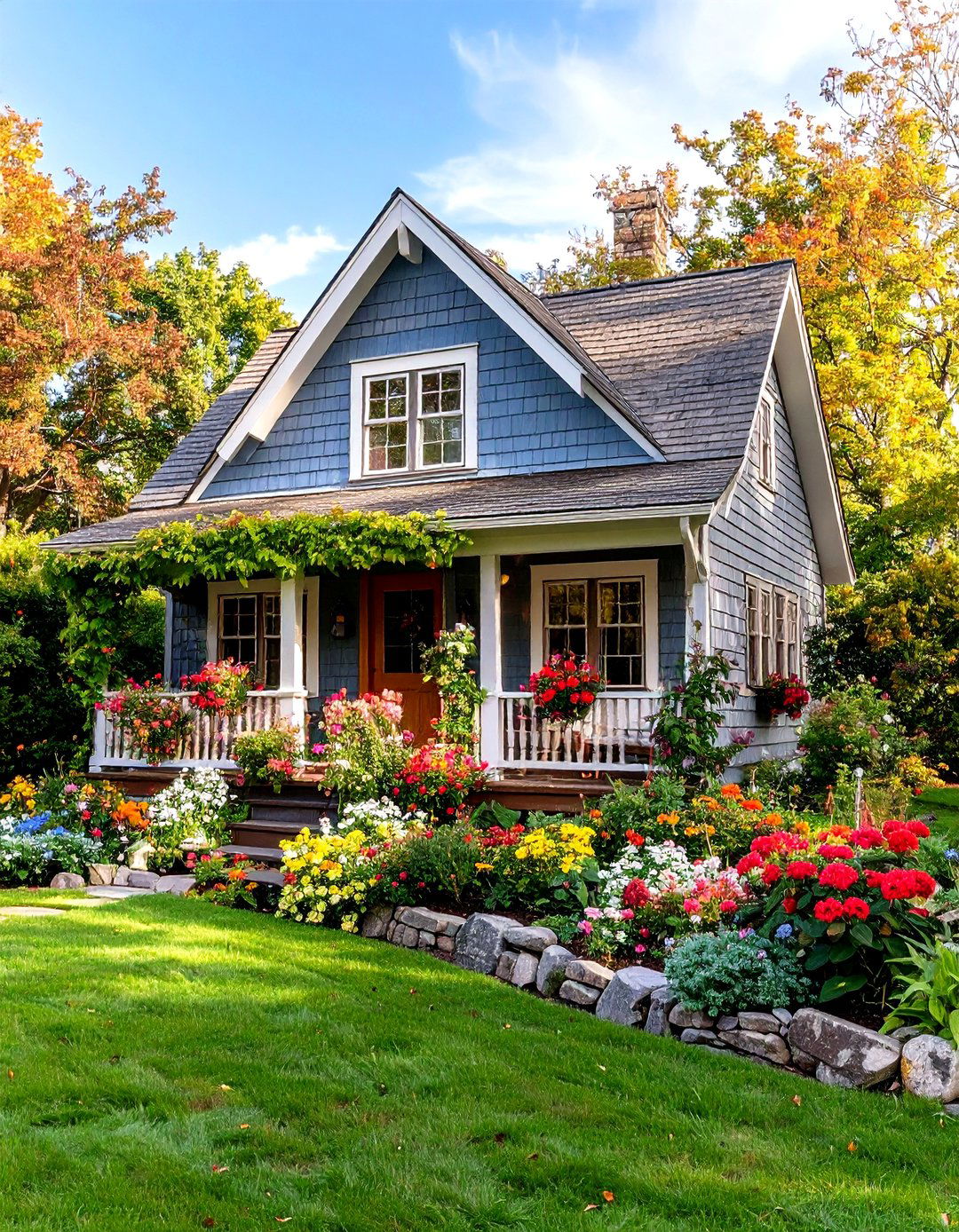

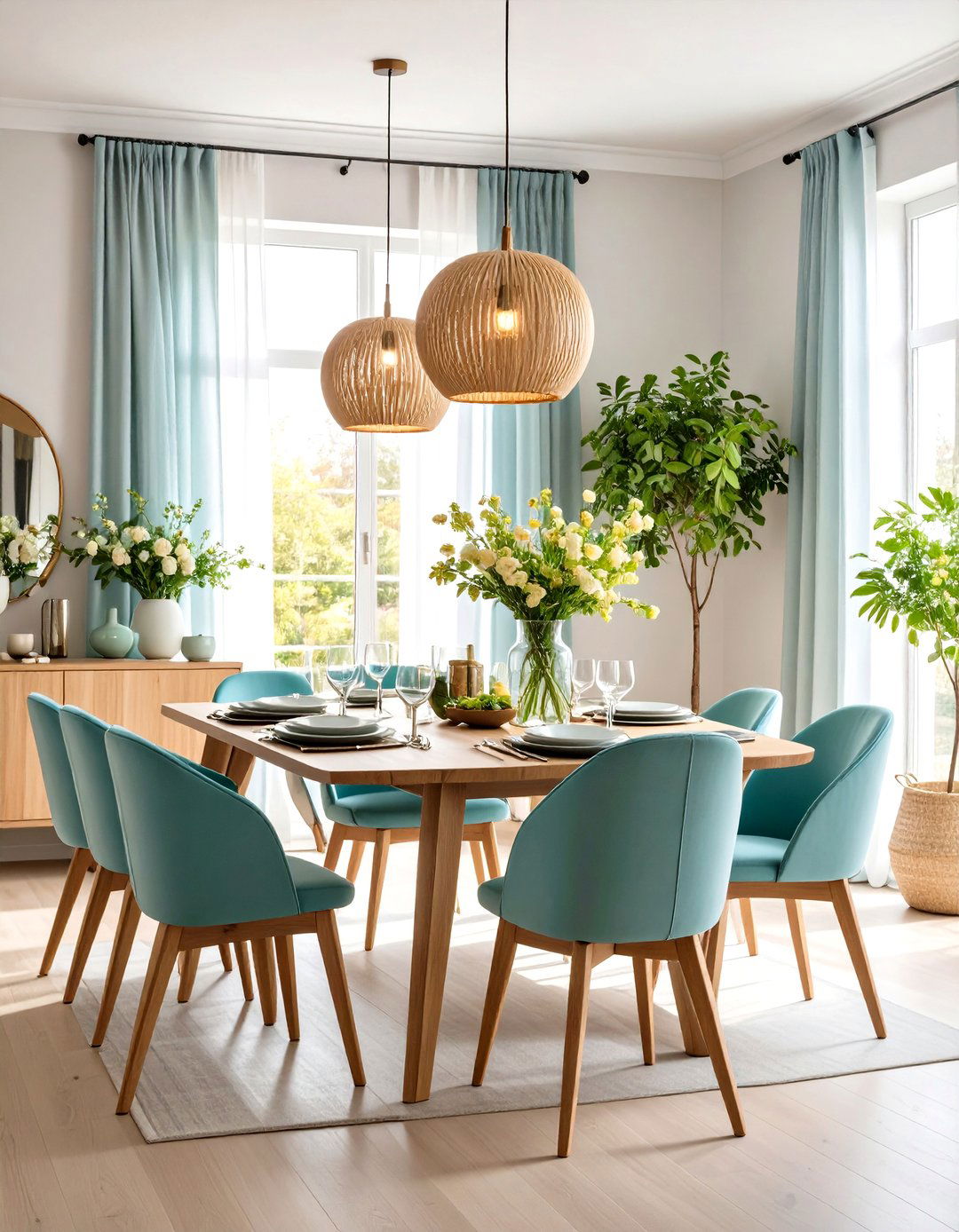
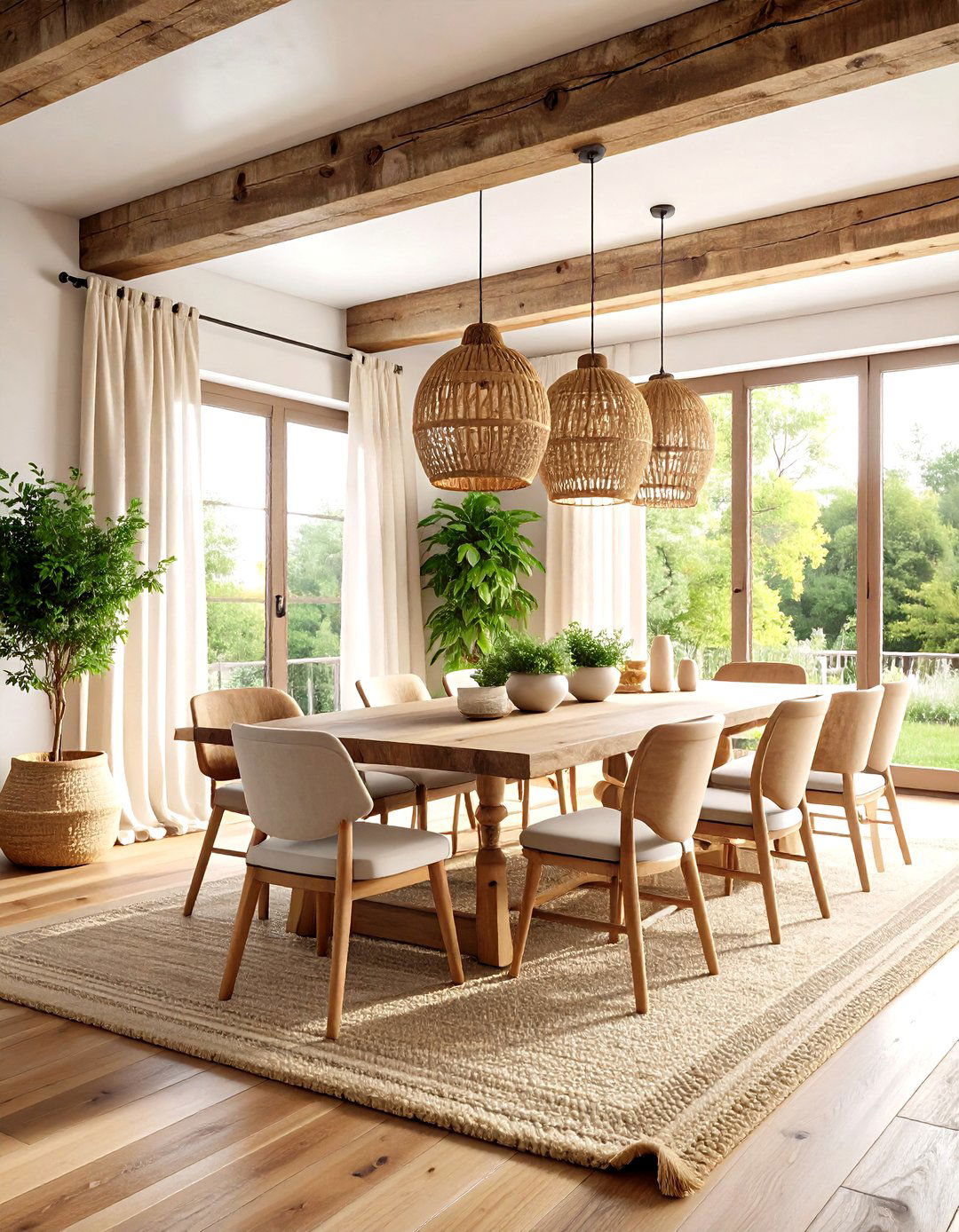
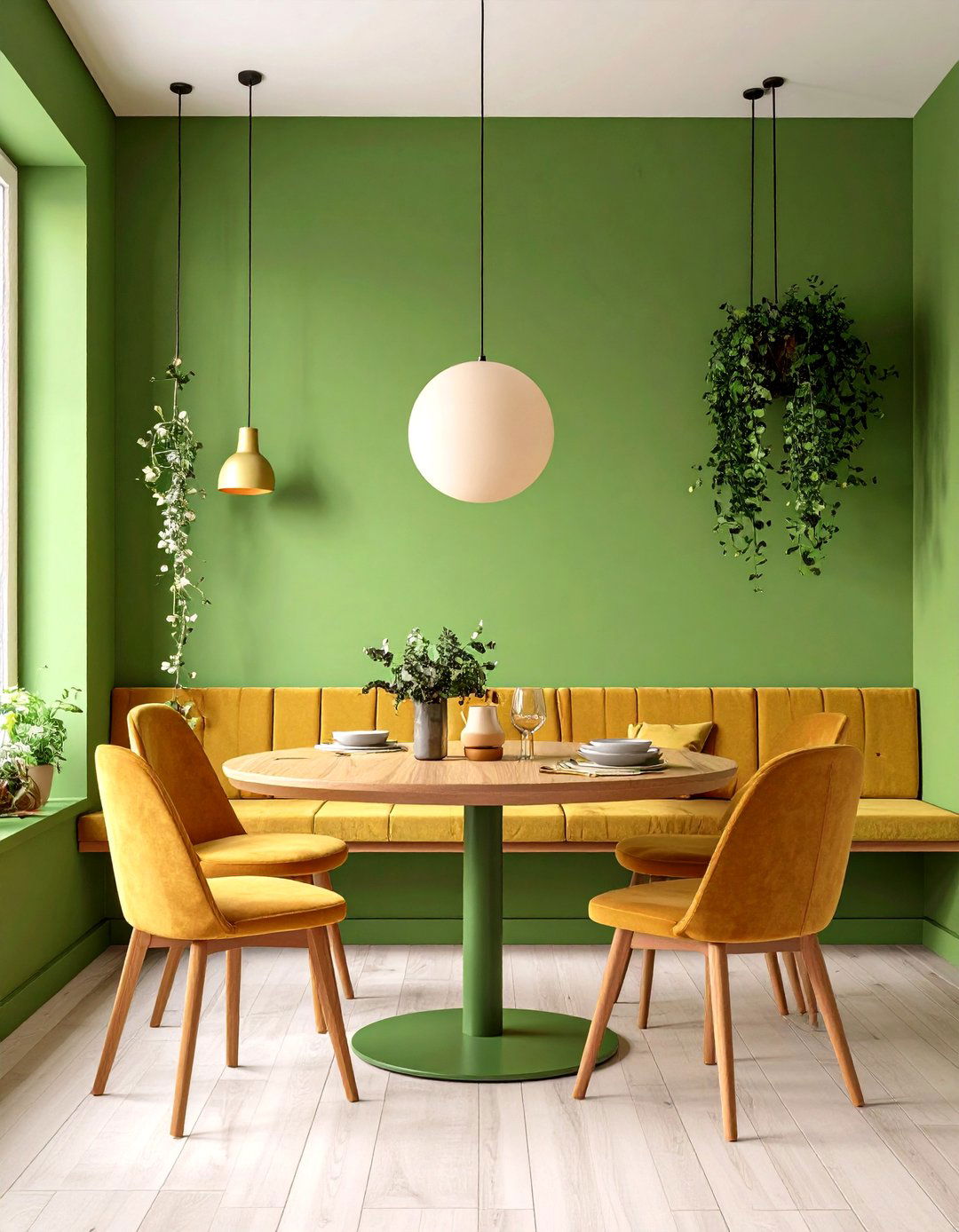
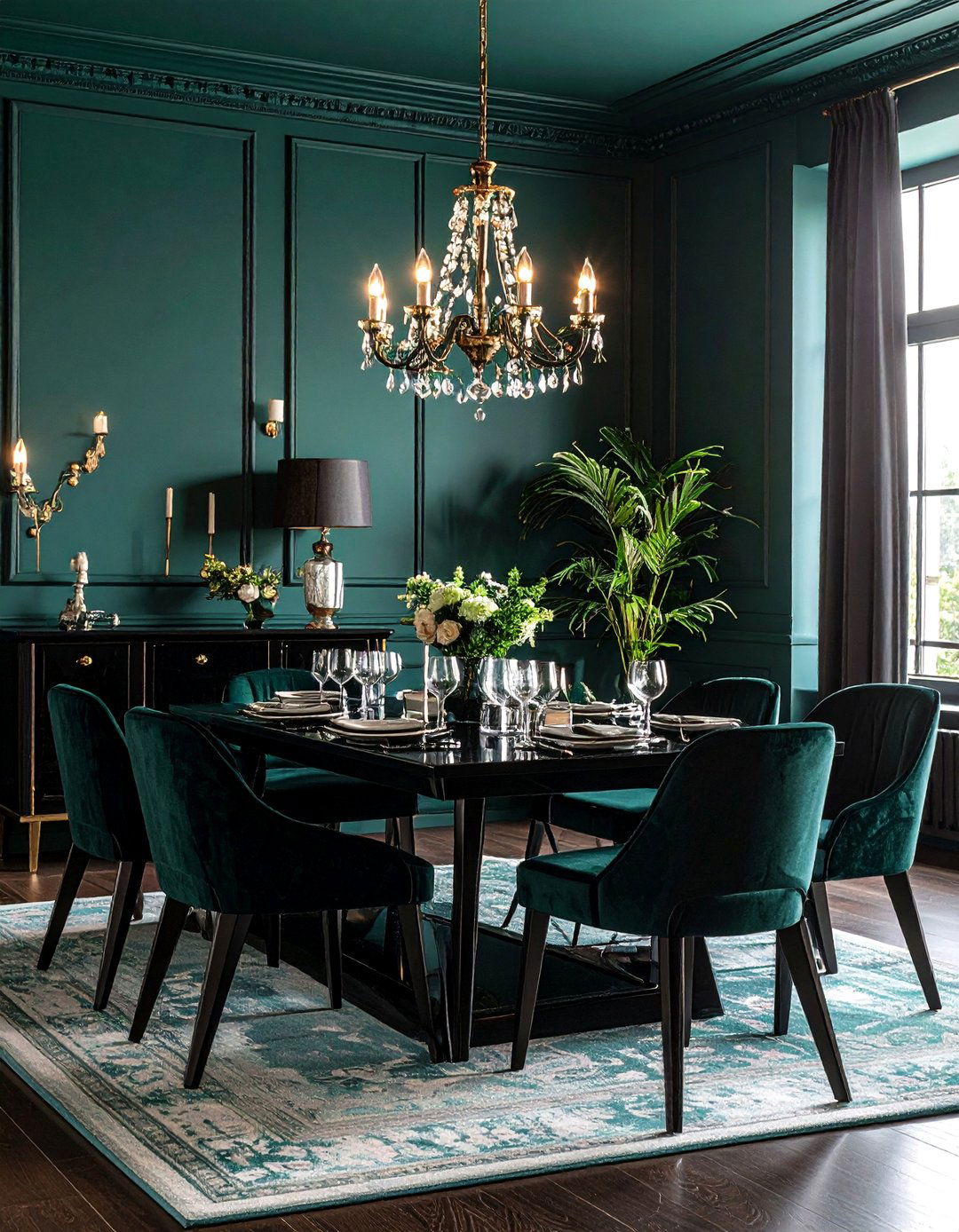
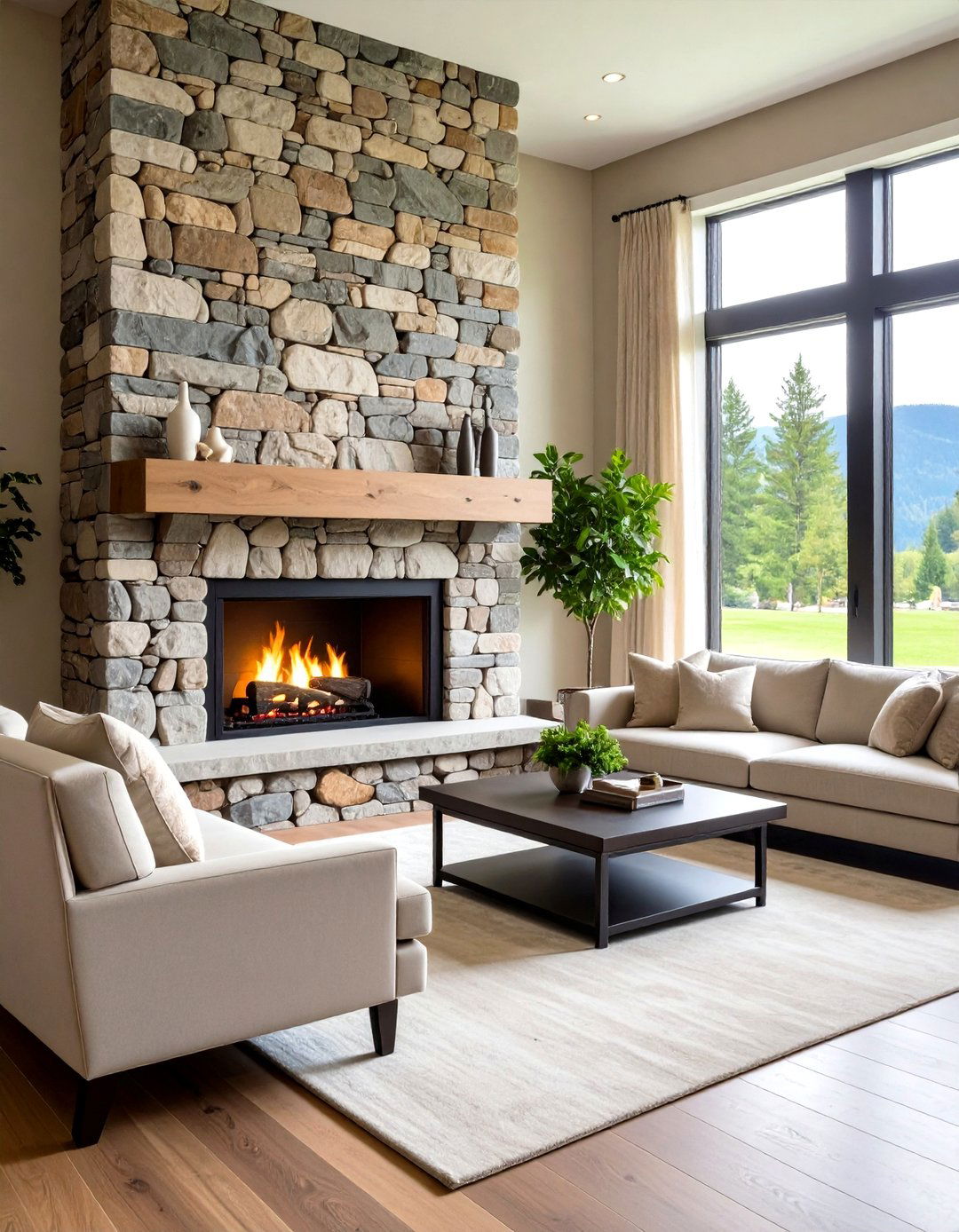
Leave a Reply